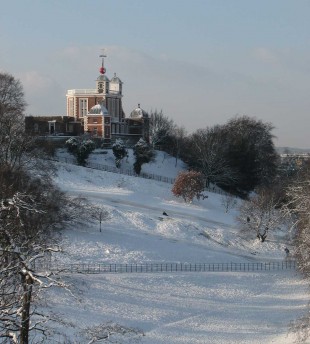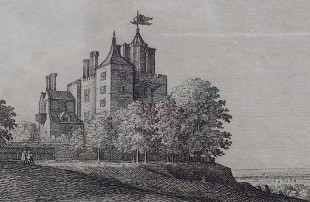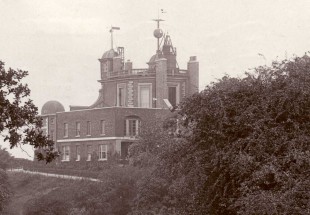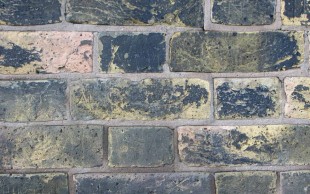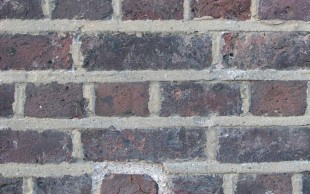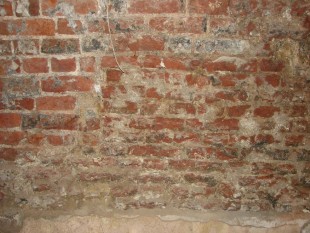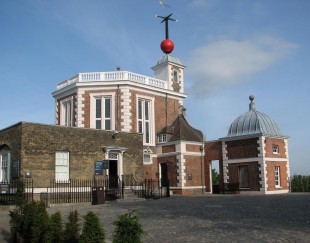…where east meets west
- Home
- Brief History
- The Greenwich Meridian
- Greenwich
(1675–1958) - Herstmonceux
(1948–1990) - Cambridge
(1990–1998) - Outstations (1822–1971)…
- – Chingford (1822–1924)
- – Deal
(1864–1927) - – Abinger
(1923–1957) - – Bristol & Bradford on Avon
(1939–1948) - – Bath
(1939–1949) - – Hartland
(1955–1967) - – Cape of Good Hope
(1959–1971)
- Administration…
- – Funding
- – Governance
- – Inventories
- – Pay
- – Regulations
- – Royal Warrants
- Contemporary Accounts
- People
- Publications
- Science
- Technology
- Telescopes
- Chronometers
- Clocks & Time
- Board of Longitude
- Libraries & Archives
- Visit
- Search
Flamsteed House
Flamsteed House is the oldest of the Observatory buildings. It was listed as an Historic Monument in 1929, an Ancient Monument on 5 April 1951 and given a Grade I listing on 8 June 1973. Begun in 1675 and completed in 1676, it has been much extended and altered. The building sits prominently on the edge of a plateau at the centre of Greenwich Park, overlooking the River Thames and the site of the former Royal Palace below.Until the move to Herstmonceux in the 1940s, its main use was as the dwelling house of the successive Astronomers Royal. It is named after its first occupant John Flamsteed. The others who subsequently lived there were Edmond Halley, James Bradley, Nathaniel Bliss, Nevil Maskelyne, John Pond, George Airy, William Christie, Frank Dyson and Harold Spencer Jones, most of whom made significant alterations.
The House as originally built
The observatory was built at the behest of King Charles II to the designs of the famous architect Sir Christopher Wren, who until 1673 had been Savilian professor of Astronomy at Oxford. Its construction was supervised by Robert Hooke. Flamsteed laid the foundation stone on 10 August 1675, and moved in the following year. The Observatory was built on the cheap, reusing the foundations of Duke Humphrey’s Tower (also known as Greenwich Castle and sometimes as Millefleur), a building that had been put up in the 1430s, remodelled in the 1520s, improved in the 1610s and demolished at some point prior to the decision being made to build an Observatory. Exactly when this was is unclear, but it was probably in the late 1660s. Click here to read more.
What is certain however is that by 1675 it had been demolished as the Observatory’s founding Warrant ordered that it was to be built ‘within our park at Greenwich, upon the highest ground, at or near the place where the castle stood’
As well as utilising pre-existing foundations, the building made use of recycled materials. In his autobiography (written in 1707/8), Flamsteed informs us that the bricks came from ‘spare stock’ at Tilbury Fort whilst some of the wood, iron and lead came from a gatehouse that had been demolished at the Tower of London. The money for its construction came from the sale of decayed gunpowder. In all, £520 9s 1d was spent, slightly exceeding the additional £500 allowed by the Royal Warrant authorising its construction. The model made of Wren’s most famous building, St Paul’s Cathedral, prior to its construction, cost about the same!
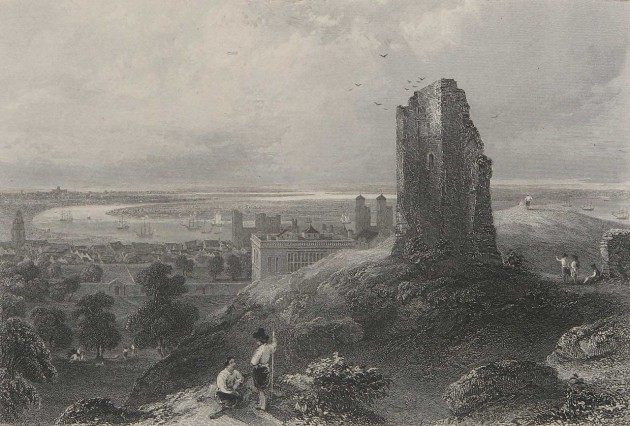
Greenwich Park and Palace, Old London in the distance, Tower in Foreground built by Humphrey Duke of Gloster. Steel engraving showing the ruins of Duke Humphrey's Tower. From Scott's Waverley Novels [Abbotsford edition] vol. 7 (1845), where it is described as being engraved by F W Topham 'From a Picture, temp. of tale', which is assumed to mean from a picture that was contemporary to the novel (which was historical). The artist is unknown. It is not known if the painting was a contemporary image or a later artist's impression. Nor is its present whereabouts known
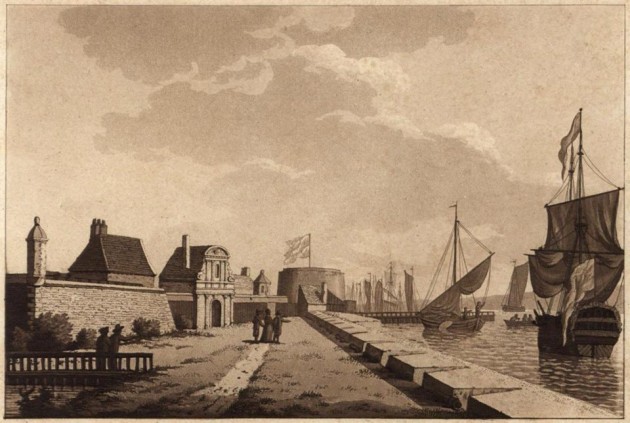
Tilbury Fort, the source of the bricks for the new Observatory. Dating from the time of Henry VIII, the Fort was located 21 miles downstream from Greenwich. It was enlarged between 1670 and 1685 to form the present star-shaped defensive work, with angular bastions and water-filled moats at a cost that is said to have exceeded £47,000. A scheduled ancient monument, the Fort is now in the care of English Heritage. Sepia aquatint by Samuel Ireland, from Vol. 2 of his Picturesque views of the Thames (T. & J. Egerton, 1792 & 1802)
The earliest known plan of the Observatory is one that was hand drawn by Flamsteed and sent by him to Richard Townley on 22 January 1676 (RS MS243/12). At this point in his life, Flamsteed was unmarried. In its original form, Flamsteed House consisted of three stories. In the basement, there was a kitchen in the south-west corner (under F in the plan below) and an unheated parlour in the south-east corner (under G), with the cellars (under C) and stores on the northern side of the building. On the ground floor, there were four main rooms: on the north side, a large hall (C) from which a staircase (K) led down to the kitchen, and the Astronomer Royal’s bedroom (D) with a study leading off it (E). On the south side there were two rooms described by Flamsteed as ‘astronomer’s rooms’.
The Observatory was entered from the Park via the gate (I), and Flamsteed House via the door (A) which lead to a small lobby (B) from which the either the hall could be entered of the stairs ascended to the floor above.
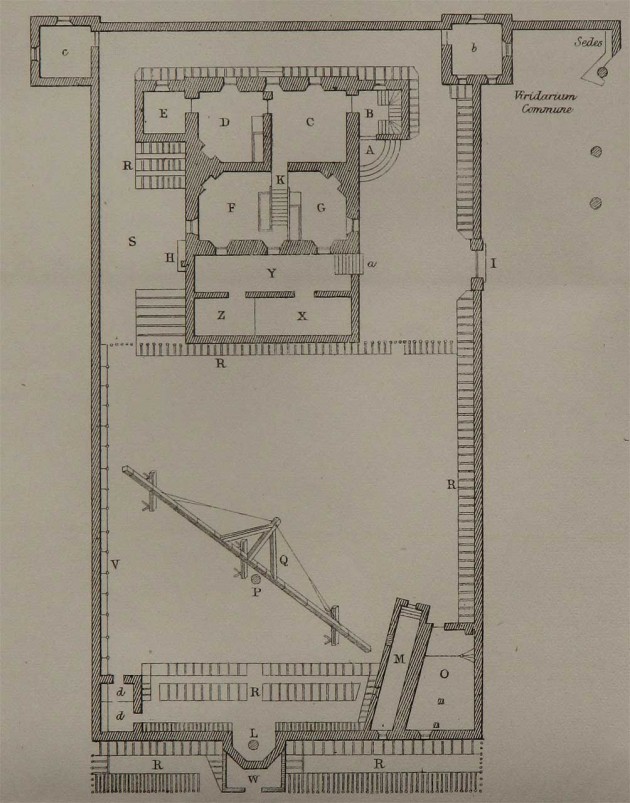
Ground floor plan and part of the basement of the Observatory c.1676. Redrawn by Airy from an engraving by Francis Place after Robert Thacker and published in the 1862 volume of Greenwich Observations
On the first floor there was just one large octagonal room. This was Flamsteed’s Camera Stellata – a room fitted out for making observations of the heavenly bodies. Formerly known as the Great Room, it has been referred to as the Octagon Room since the 1830s. It is noteworthy both as a rare survival of a domestic interior by Wren and also for its great height – required in part to accommodate the four metre long pendulums of the Tompion Clocks which were built into the north-eastern wall.
Tall windows, three with balconies, on six of its eight sides gave the astronomers within a good view of the Sun, Moon, planets and Pole Star, while a small stairway hidden behind the panelling in the north-west corner gave access via the western turret to the flat roof, where a 16-foot telescope (later replaced by a 27-foot one) was mounted. A larger 60-foot telescope (Q) suspended from an old ships mast (P) was available on the lawn below. Beneath the eastern turret, there was a very cramped ‘lodging room’ for a servant. At basement level to the south of the building, and separated from it by a small yard (Y), were a workshop (X) and a washhouse (Z) containing an oven. The yard was accessible from both Flamsteed House and the outside via the steps (a).
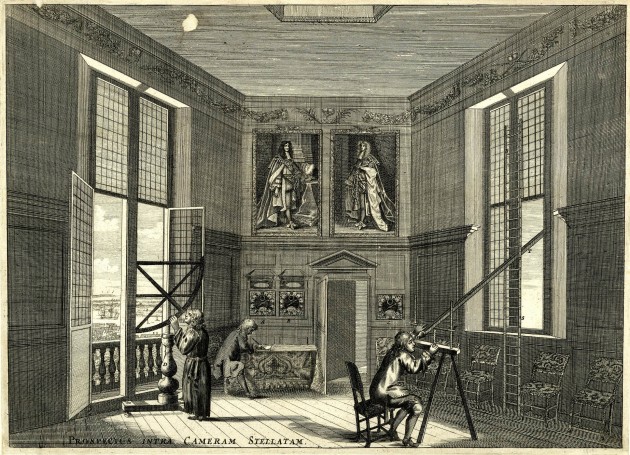
The Octagon Room with an observer at the eyepiece of the 8-foot refractor at the eastern window (right). There does not appear to be a micrometer attached to it. Key: (A) & (B) The two year going Tompion Clocks presented to Flamsteed by Sir Jonas Moore. (C) A further clock about which little is known. (D) 3-foot moveable quadrant. (F) Stand for supporting the eye-end of the telescope tube with a screw mechanism for adjusting its height (S) Ladder for supporting the object-glass end of a telescope tube. (T) the 8-foot telescope tube (with square cross-section). It is not known if there were also ladders attached to the south and west windows or if the ladder at the east window was moved to other locations as required. Etching by Francis Place after Robert Thacker c.1677–78. © The Trustees of the British Museum (CC BY-NC-SA 4.0). Museum number: 1865,0610.952
Meanwhile, outside, the north-facing window of the Octagon Room was flanked on either side by dummy windows whose presence gives the building a sense of balance and poise. The north facing windows on the ground floor below, were five in number and symmetrically placed along the frontage, the one in the centre being directly beneath the tall window of the Octagon Room above. Such a placing added greatly to the building’s external appearance, but internally, things were less straightforward. Having chosen to make the hall and bedroom about the same size (perhaps as a result of the positioning of the old foundations), Wren was faced with the prospect of the dividing wall that separated them also dividing the central window. He chose instead to incorporate the window into the hall, creating in the process, a rather odd little alcove. A survey conducted in the 1920s and published in 1930 for the Royal Commission on Historic Monuments states that this window had at some point been converted into a doorway and subsequently converted back again, citing as evidence the blocking that was present beneath the sill. Either this statement is incorrect, or else all evidence of the blocking has been skilfully removed. Only an analysis of the mortar is likely to reveal the truth.
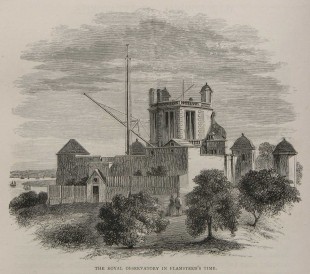
The Royal Observatory in Flamsteed's Time. Redrawn for Dunkin from an engraving by Francis Place after Robert Thacker c.1676 and published in the 1862 volume of The Leisure Hour and in the 1891 edition of The Midnight Sky. Flamsteed's Quadrant and Sextant Houses are in the south-east corner immediately above the two figures
In the garden, to the south of the main building (and demolished between 1847 and 1861), were two adjoining necessary houses or toilets (d,d). They were in the south-west corner, whilst in the south-east corner, a small detached building, aligned to the meridian, housed Flamsteed’s main observing instruments. It was divided into two parts – the Sextant house to the east (O) and the Quadrant House to the west (M). Between this building and the necessary house, there was a sundial (L). Immediately to its south and set below it into the retaining wall, there was a small Garden Room or potting shed (W). This opened directly out onto the park, but is also thought to have been connected to the vicinity of the basement of the main house by a subterranean passage. The Quadrant House and Sextant House are covered in more detail in the section on the Meridian Building. Other things marked by Flamsteed on the plan are the pump for the cistern (H), the vegetable garden (S), flower gardens (R) and a store for the 60-foot telescope tube (V).
The alignment of Flamsteed House
Over the years, there has been ongoing speculation about the alignment of both Flamsteed House and the Quadrant House. Flamsteed, who liked to have a good moan, kick-started the discussions amongst historians with his remark:
‘It were much to be wished our walls might have beene Meridionall but for saveing of Charges it was thought fit to build upon the old ones which are 13º½ false and wide of the true meridian ...’. (RS MS243/12)
The merits of his claim are worth examining. When completed, the Observatory looked down towards the Queen’s House and the old Tudor/Stuart Palace that fronted the river … and they looked back at it. The foundations of Duke Humphrey’s tower were massively thick. It is not inconceivable that the new building could have been built on them to align to the meridian had Wren so desired it. But there were at least two good reasons for not doing so. The first is aesthetic, the second practical. Standing proud on the top of the hill, instead of showing its best face to the Queen’s House, it would have been turned to one side and visually less pleasing. Without roof openings, the alignment would in any case have been immaterial. Given that Flamsteed House was designed in part as a heated dwelling house, it made more sense to locate the main observing instruments in a separate unheated building. This would not only have improved the seeing (though this is unlikely to have been a consideration), but the repercussions would be less serious should the roof openings have proved less than 100% watertight.
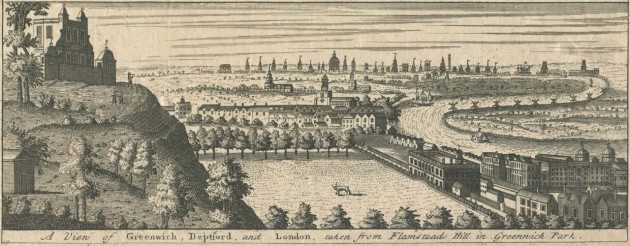
A view of Greenwich, Deptford, and London, taken from Flamsteads Hill in Greenwich Park. published by John Bowles in 1723/4. The image, which shows a distorted perspective of the Observatory from the east, was copied from an engraving with the same title which was drawn and engraved by Sutton Nicholls in 1723 and sold by Henry Overton
The great storm of 1703
In late 1703, the southern part of Great Britain was battered by a great storm that raged for several days with the strongest winds and most severe damage occurring on the night of 26–27 November. It is thought to be the most damaging to have occurred in southern Britain since the Observatory's foundation in 1675. At the Observatory, the three chimneys of Flamsteed House were all blown down and many of the windows damaged. The one piece of good news however was that by falling onto the flat roof, the weight of the western chimneys prevented the lead covering being ripped off in the gale. Click here to read more.
Halley’s transit room
The first addition to Flamsteed House seems to have been made for Halley in 1721, when a ‘little boarded shed’ was erected to house the new transit instrument. Squeezed into an awkward corner near the western summerhouse, it was located between the boundary wall and what had been Flamsteed’s study. It was described in 1726 as ‘a little room built on purpose, adjoing to the west side of the Observatory’. The only plan on which it is known to appear is that drawn by John Evelegh between 1750 and 1773 (below). It implies the presence of a brick built room rather than a shed. The presence of either is conspicuously absent in all known contemporary images.
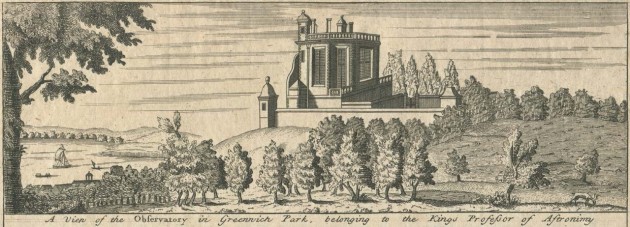
A view of the Observatory in Greenwich Park belonging to the King's Professor of Astronimy published by John Bowles in 1723/4. The image, which shows the Observatory from the west, may have been copied from an earlier engraving titled: The East Prospect of Dr Flamstead's House in Greenwich Park which was printed and sold by Henry Overton, but seemingly not published until 1724. A key difference from earlier views is the absence of the mast telescopes
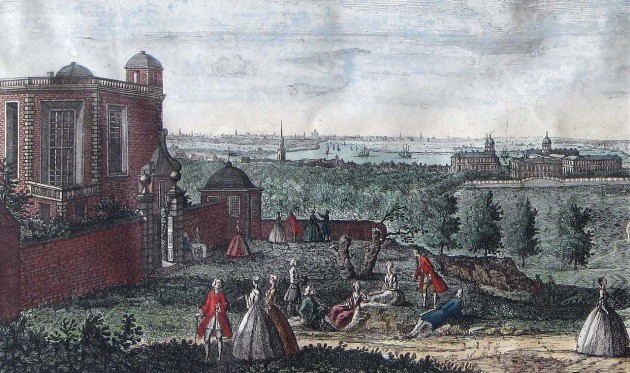
The Observatory in 1736. On the extreme left, the corner of Halley's Quadrant House can be seen breaking through the boundary wall. Detail from Prospect of Greenwich from the Observatory... . Engraved by St. Torres after J. Rigaud, 1736. Printed for Robert Wilkinson London (No. 58 Cornhill)
Bradley’s alterations
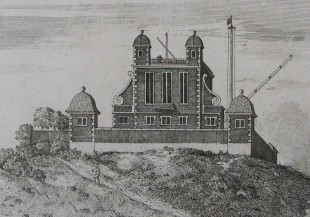
The north side of Flamsteed House in the 1670s. Detail from an engraving by Francis Place after Robert Thacker c.1676. Reproduced courtesy of Greenwich Heritage Centre
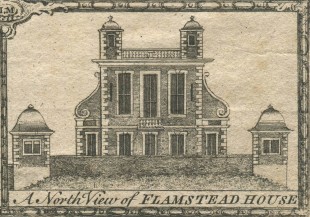
A later view of the north side published in 1749. Note the change to the ground floor windows. Detail from Greenwich Park for The London Magazine
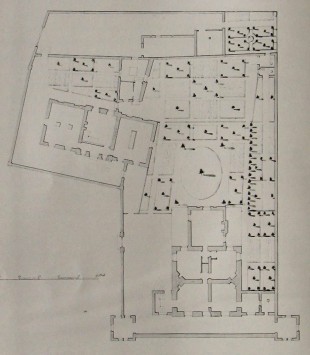
John Evelegh's plan of the Observatory. Drawn between 1750 and 1773 it was republished in QJRAS in 1963
The first extension was added for Bradley in 1750. Constructed on the south side of Flamsteed House, it consisted of a basement kitchen with ancillary rooms on ether side that stretched the full width of the south side of the house, together with a less wide living room on the main floor above which can be seen in Evelegh’s plan (right). At about the same time – the evidence suggests between 1746 and 1749 – the five north-facing windows on the ground floor were enlarged to their present size.
Maskelyne’s alterations
The modified appearance of Flamsteed House today probably owes more to Maskelyne than any of its other occupants. Maskelyne took up on his appointment as Astronomer Royal in 1765 at the age of 33. His first proposed alteration came in 1770, and was for the erection of two new observatory buildings to house a replacement for Graham’s Equatorial Sector. Each would have been 12 feet square and accessed from entry points cut into the east and west sides of the Great Room. The proposal was opposed by the Visitors, who suggested instead that the summerhouses be modified to accept them. The summerhouses were duly converted, coming into use in 1773 (more about this below).
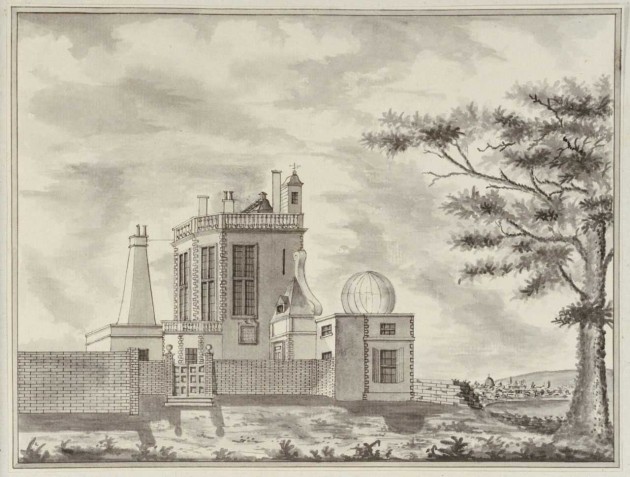
Flamsteed House from the east with Bradley's extension on the left. Maskelyne's newly converted Eastern Summerhouse on the right dates the image to no earlier than 1773. The form of the Octagon Room windows suggest that the image predates their alteration in 1779. Drawing by John Charnock. Reproduced under the terms of the Creative Commons Attribution-Non-Commercial-ShareAlike (CC BY-NC-SA) licence courtesy of the National Maritime Museum, Greenwich, London (see below)
During 1778 and into 1779, Maskelyne proposed numerous upgrades and alterations to the Observatory’s instruments and buildings, including the heating arrangements and kitchen. The proposals are recorded in the minutes of the Visitors (RGO6/21). It is difficult to know which were carried through. Many clearly were. The openings though which Maskelyne observed were widened in 1779. In the second of his four volumes of Greenwich Observations (p.160), he records:
‘The Windows of the Great Room are now turned into glass Doors, opening in four Parts, two in Width and two in Height, so that the Whole or Part may be opened at Pleasure; the whole Width of the Opening being now being extended to four Feet, which before was not quite two Feet, as the windows then only opened on one Side.’
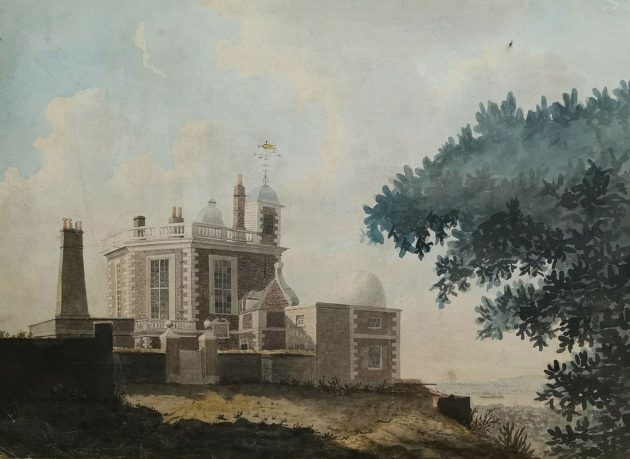
Similar to, but later than the image immediately above, the most obvious difference is the arrival of a number of additional chimney pots. The tall windows of the Octagon Room appear to have a much thinner division between their right and left halves, suggesting that they are the new windows installed in 1779. In both views, the camera obscura mounted on top of the western turret is clearly visible. The image has the following inscription by Maskelyne's daughter Margaret on the rear: 'Royal Observatory Greenwich as it was in 1794 drawn by Mr S[?]inley'. The date however is clearly incorrect as the construction work to replace Bradley's extension began in 1789 and the courtyard was extended towards the viewer in 1791. Watercolour reproduced courtesy of The Petersfield Bookshop (see below)
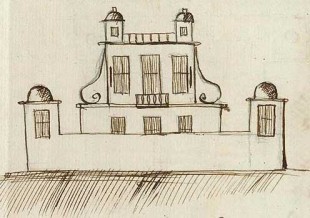
Flamsteed House from the north in October 1777. Crude sketch by Thomas Bugge, professor of mathematics and astronomy at the University of Copenhagen. Reproduced under the terms of the Creative Commons Attribution-NonCommercial-NoDerivs (BY-NC-ND) licence courtesy of Det Kongelige Bibliotek, Denmark (see below)
In 1778, Maskelyne asked for a covered passageway to connect Flamsteed House with the Quadrant Room. This was never built. He also sought to enclose ‘the triangular piece of ground at the entrance of the observatory’ (RGO6/21/164). This didn’t happen then, but did eventually in 1791 when the present courtyard was created (Click here for more details). He also asked for a new set of entry gates and a Swedish Stove for the Great Room. At some point (date unknown), a closet room was carved out of the landing outside the Great Room. This was believed by Airy to have been created for Maskelyne’s footman. In 1840, it contained shelves carrying printed copies of Greenwich Observations and Groombridge’s Catalogue which had been published by Airy in 1838 (RGO6/54/72). The closet was removed by Airy in 1866/67. The scarring left behind can still be seen to this day.
Maskelyne married in 1784 and had a daughter the following year. The accommodation no longer being adequate, the Duke of Richmond, Master General of the Ordnance, authorised the replacement of Bradley’s extension in July 1789. Like Bradley’s, Maskelyne’s ran along the south side of Wren’s building. Unlike Bradley’s which was narrower than Wren's building, Maskelyne’s was wider and blocked the south facing windows on the ground floor. According to his Memorandum Book, Maskelyne himself laid the ‘foundation’ on 2 October 1789. having the previous day measured the depth of the foundations, as 13 feet 8.3 inches below the level of the parlour of the old house (RGO218/2/6).
At that time, the Observatory is known to have obtained at least some of its water from an underground tank immediately to the south of Flamsteed House. This was now supplemented by at least two lead water tanks or cisterns. Carrying the date 1790 together with the arms of the Board of Ordnance (three cannons), the tanks were moved with the Observatory to Herstmonceux where they were used a planters for flowers. They were subsequently moved to the Observatory’s third home in Cambridge. Following the closure of the Observatory in 1998, they were returned to Greenwich, where they are now in the care of the National Maritime Museum. They have been in store since that time.
The new extension (which may have incorporated sections of brickwork from the earlier one); provided Maskelyne with three decent sized basement rooms (which according to his daughter were a laundry, a kitchen and a housekeeper’s room (RGO6/44/11) with three similar sized rooms on the main floor above. The rest of the house was altered and modernised at the same time. The fireplaces were relocated and the old stairs to the basement repositioned. It was probably at this time that the vaults that now form the public toilets under the courtyard were crafted – possibly out of a long forgotten basement room of the old castle. They were put into use as coal cellars. There are no known contemporary plans or images, but two later plans from 1831 and 1835 (RGO6/45) give a good indication of the internal layout in Maskelyne’s time. They show the three rooms on the main floor having windows on the south side only, the eastern room by the entrance being used as a library (presumably the Astronomer Royal’s private one as there was an Observatory library at the eastern end of the Meridian Building) and the central and western ones as interconnecting drawing rooms.
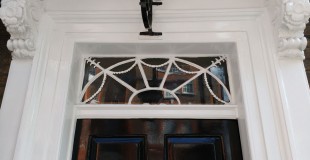
The original fanlight (see Elizabeth Smith's drawing of Flamsteed house below), was similar to this one that still exists on a grade II* listed building in Church Row, Hampstead. Photographed 2017
The Great Room windows of 1779 appear to have been short-lived and substituted with regular double hung sashes. When this happened is unclear, but in all probability it was during the 1790 makeover, which is probably when the small balcony beneath the north-facing window was changed for a more modern semicircular metal one. It was in about 1790 that the Great Room was largely abandoned as an observing space. Had it been abandoned earlier, the cost and disruption of changing the windows in 1779 could have been avoided.
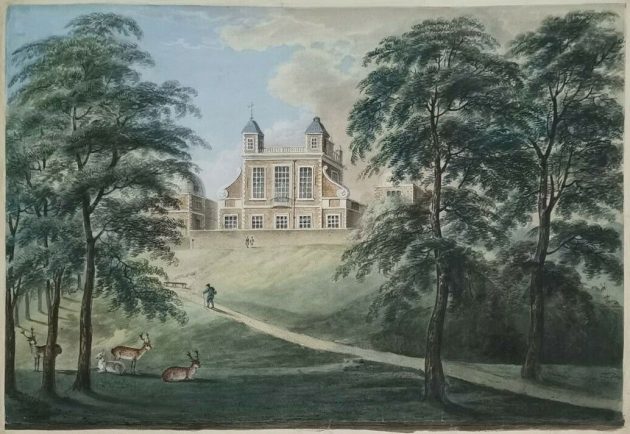
The north front of Flamsteed House in 1801. Note the newly installed sash windows of the Octagon Room. Watercolour by Margaret Maskelyne. Painted when she was just 16 year old, it is inscribed "M. Maskelyne Delint '01" (bottom left). Reproduced courtesy of The Petersfield Bookshop (see below)
Monstrous carbuncles?
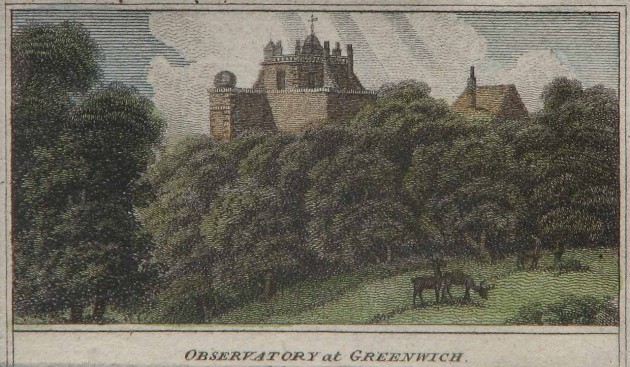
Dating from the late eighteenth or early nineteenth century, this crude view from the west was drawn before the addition of Airy's extension in 1835. Although topographically inaccurate, it does show the two large chimneys of Maskelyne's extension, the altered summerhouse and what appears to be the roof of the central section of Bradley's New Observatory. Measuring just 5.6 cm by 2.8 cm, the image is thought to have been published in an almanac
Whilst the extensions may have been regarded as unsightly and viewpoints therefore chosen to deliberately exclude them, it is also possible that artists ignored them because they were largely obscured by the boundary wall and gates to the east, and by the growth of trees to the west.
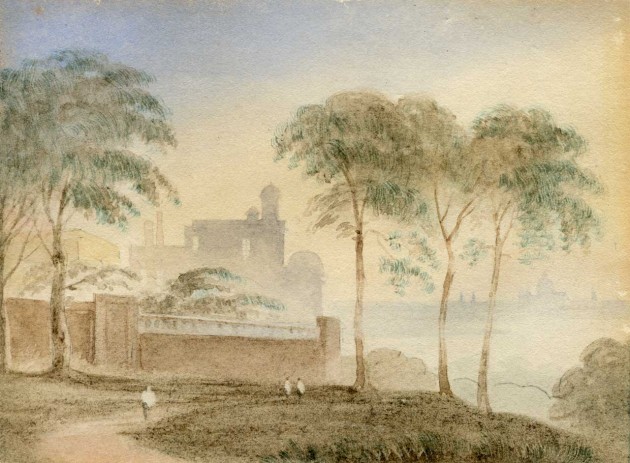
The Observatory with St. Paul's in the distance. Watercolour, (115 x 156mm). Attributed to John Varley (1778–1842)
Pond’s alterations
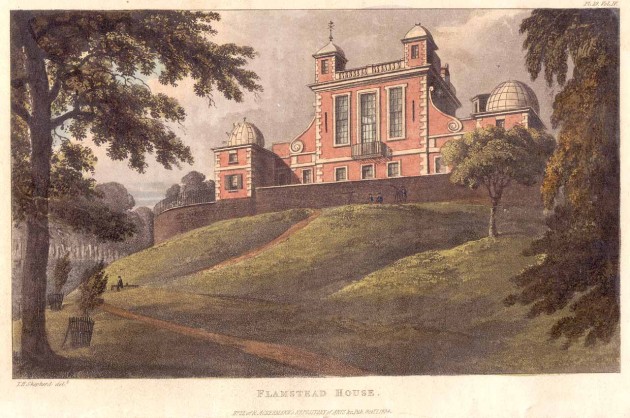
Flamsteed House. Drawn by TH Shepherd and published on 1 October 1824 by R Ackermann in his Repository of Arts, Literature, Fashions &c.. In this view from the north, the top of the room created by Pond for the Great Zenith Tube is visible above the tree on the right (immediately to the left of the dome on the former summerhouse). It can be seen more clearly in the slightly later below.
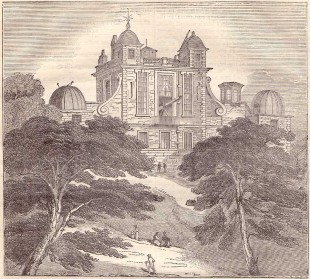
Greenwich Observatory. The time ball (not shown) was added in the same year that the image was published. From the 12 December 1833 edition of The Mirror of Literature, Amusement and Instruction
Although Pond extended both the Observatory Grounds and the Meridian Building, apart from the addition of the time ball on the roof in 1833, he made only one other change to Flamsteed House. The ground between the western summerhouse, the boundary wall and Flamsteed’s study on which Halley’s transit instrument had stood, was excavated in 1820 to create a room ready to receive his 25-foot Great Zenith Tube. It was described by Airy as ‘a square tower like a steeple’. At the same time, to give uniformity to the appearance of the important north front of Flamsteed House, the wall was built which connects Flamsteed House to the eastern summerhouse. The Great Zenith Tube was never a success and was removed by Airy in 1848, the space being incorporated into the dwelling house, along with the adjoining summerhouse, whose doorway onto the north terrace was bricked up at the same time.
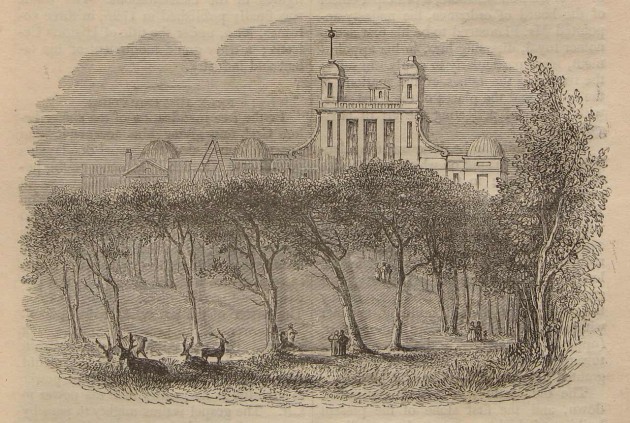
The Royal Observatory from the north with Ramage's 25-foot telescope rising up from the Courtyard and the newly installed time ball on the roof of Flamsteed House. Curiously, the 1820 addition to Flamsteed House for the Great Zenith Tube has been omitted. From The Weekly Visitor, (3 Feb, 1835)
Airy’s alterations and a question of taste
Airy had a larger family than his predecessors. Prior to his taking up residence, a single story wing with three good sized rooms was added on the western side of the building in 1835/6. A fourth room was also created. It had no external walls and relied on borrowed light from a skylight above a new and adjacent staircase for its illumination. The staircase gave access to a small basement below the central room of the new wing that was excavated at the same time to house a lavatory and an adjoining pit. The works were overseen by the Admiralty’s Civil Architect, George Ledwell Taylor, who first visited Airy to discuss what was required on 14 August 1835 (Airy Autobiography).
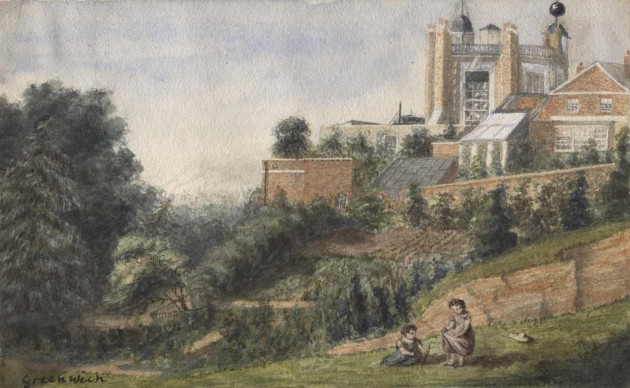
Flamsteed House, the Garden House and part of the Meridian Building from the south in about 1841-43. In the centre of the view, the pitched roof of Airy's extension can be seen rising above the trees. Watercolour painting by Henrietta Smythe. © The Scout Association Heritage Collection (see below)
A few years later, in 1839, a small covered porch was built at the top of the steps in front of the entrance that had been created by Maskelyne, together with a covered passageway leading from there to the western corner of the Meridian Building. At the same time, the easternmost of Maskelyne’s suite of rooms, still in use as a library in 1835, but now in use as a dining room, had a new opening inserted in the blank window on the eastern side overlooking the courtyard (and covered way) (RGO6/45/24). The covered way was extended eastwards along the north side of the Meridian Building to the gate leading from the courtyard into the Park in 1857/8.
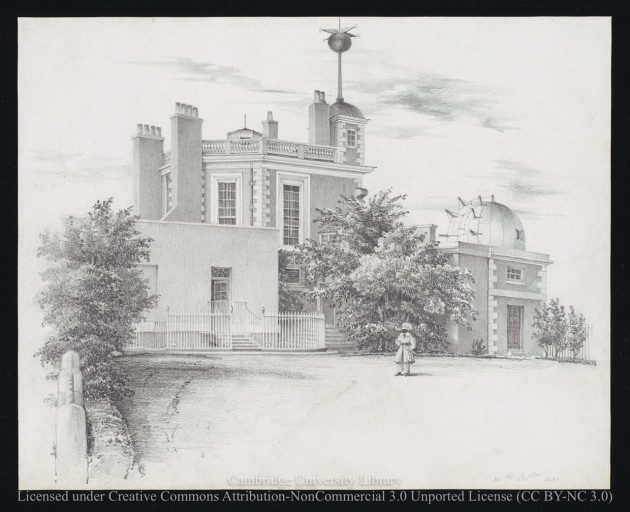
Flamsteed House from the East prior to the addition of the porch. Pencil drawing by Elizabeth Smith, 18 October 1838. Reproduced under the terms of a Creative Commons Attribution-Non-Commercial 3.0 Unported License (CC BY-NC 3.0) courtesy of Cambridge Digital Library (see below)
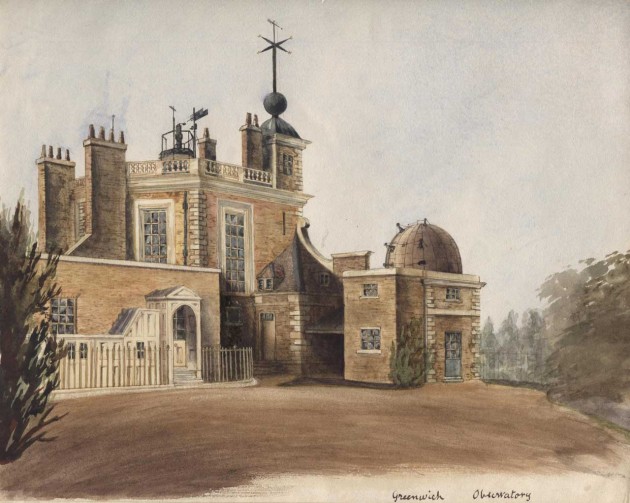
Flamsteed House from the east in about 1843-49. Watercolour painting by Henrietta Smythe. © The Scout Association Heritage Collection (see below)
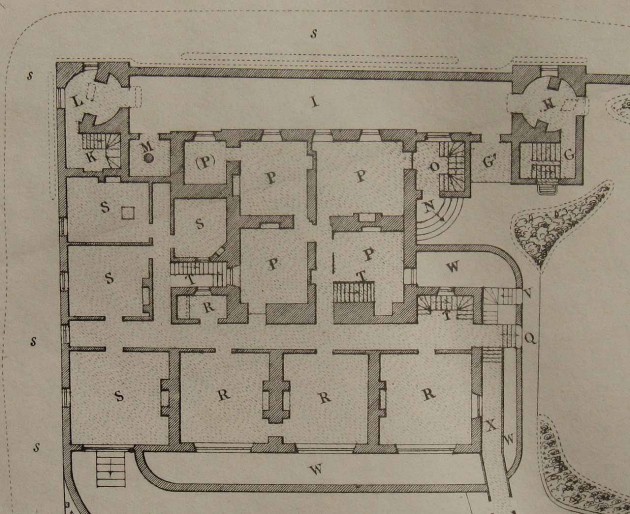
Ground floor plan of Flamsteed House and the converted summerhouses (the North-East and North-West Domes) in 1847. Detail from a plan published as an addendum to the 1845 volume of Greenwich Observations. Key: (G) staircase to the North-East Dome. (G') an open shed. (H) ground floor of North-East Dome. (I), North Terrace. (K) staircase to the North-West Dome and the upper part of the Zenith Tube. (L) ground floor of the North-West Dome. (M) Zenith Tube Room. (N) entrance used to access the Octagon Room and formerly the whole of Flamsteed House. (O) staircase up to the Octagon Room. (P) apartments originally constructed for Flamsteed, with the Octagon Room above. (Q) new entrance to Flamsteed House created when Maskelyne's extension was built. (R) rooms built for Maskelyne. (S) rooms built for Airy. (T) staircases descending to the kitchens and cellars. (V) staircase descending to open area at basement level. (W) open area at basement level. (X) Covered way leading to the Meridian Building. (s) public path in the Park
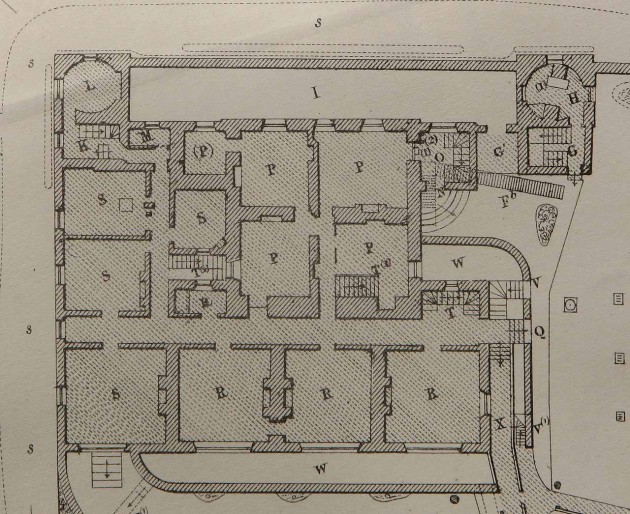
Ground floor plan of Flamsteed House and the converted former summerhouses (the North and old North-West Domes) in 1863. Detail from a plan published as an addendix to the 1862 volume of Greenwich Observations. Key: (Fb) external staircase to Octagon Room roof. (G) staircase to the North Dome (previously known as the North-East Dome) and the lobby to the Chronographic Room. (G') an open shed. (H) ground floor of North Dome (the Chronographic Room), (1) chronographic apparatus. (I), North Terrace. (K) staircase to the old North-West Dome. (L) ground floor of the old North-West Dome. (M) closet. (N) entrance used to access the Octagon Room and formerly the whole of Flamsteed House, (1) Mean Solar Time clock, (2) apparatus for dropping the Time Ball. (O) staircase up to the Octagon Room. (P) apartments originally constructed for Flamsteed, with the Octagon Room above. (Q) new entrance to Flamsteed House created when Maskelyne's extension was built. (R) rooms built for Maskelyne. (S) rooms built for Airy. (T, T1 and T2) staircases descending to the kitchens and cellars, the staircase (T) also rising to the Octagon Room. (V, V1) staircases descending to open area at basement level. (W) open area at basement level. (X) Covered way leading to the Meridian Building. (s) public path in the Park
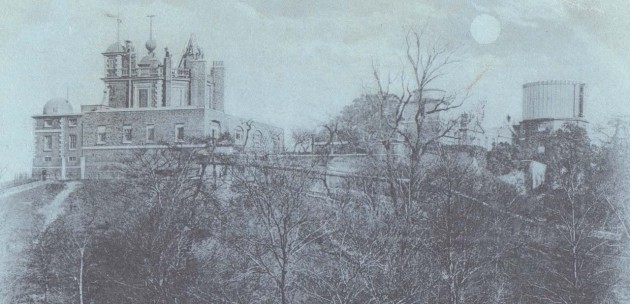
The Observatory from the west. Flamsteed House, with Airy's extension to the fore, is on the left and the Great Equatorial Building with its drum dome on the right. The Observatory would have looked much like this from the late 1860s until the late 1880s when Christie built the Astrographic Dome. Detail from a postcard published anonymously c.1900
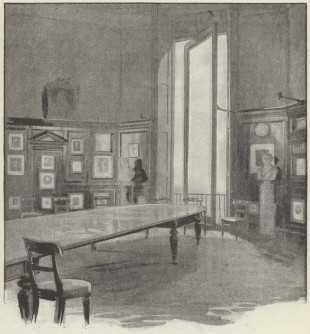
Internal view of the Octagon Room in the late 1890s. Airy's plate-glass window is in the centre facing north. The staircase up to the roof was behind the door on the left. In today's museum, it also leads to the gallery on the floor below. From The Leisure Hour (1898)
‘Some ignorant carpenter, to make place for these insignificant shelvings, had cut through Sir Christopher Wren’s cornices and mouldings, and had planed the astragals off from the pannels; so that it was impossible to remove the obstructive additions without undertaking the heavy work of restoring the cornices, &c. After many years’ endurance of the unsightly fixtures, I at length determined at all events to remove them, and in the last autumn (the first time for perhaps half a century), the shelves, &c. were taken down, the cornices, &c. were restored, and the room was exhibited in the form in which the celebrated architect left it.’
It would seem that the Octagon Room window was not the only one in the house to be modernised by Airy. Similar windows were fitted in the Drawing Room and hall passage – presumably at about the same time.
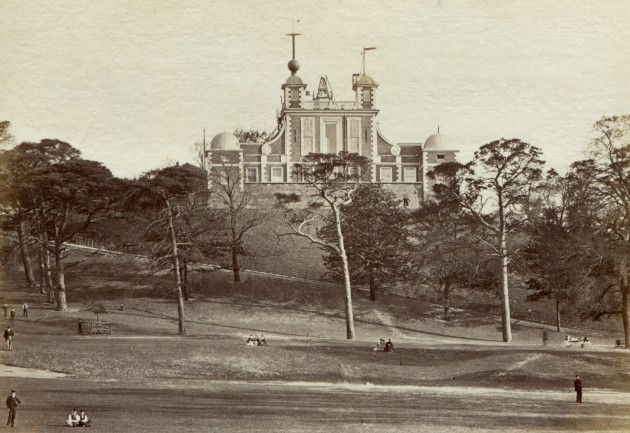
In this 1870s view, Flamsteed House has been photographed from the north. The Great Equatorial Building with its drum dome is just visible on the left. Note the plate-glass window installed in the Octagon Room in 1857/8. Albumen print by an unknown photographer
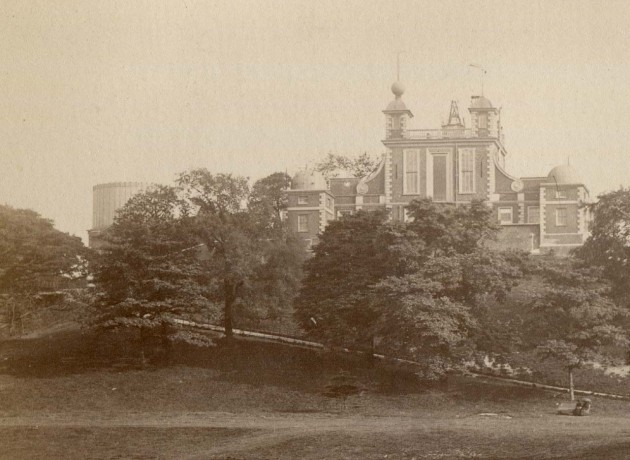
The key difference between this 1880s view and the one above is the appearance of the circular opening in the wall between Flamsteed House and the left-hand (eastern) summerhouse (inserted in early 1880) and the felling of the Scots Pines in the foreground. Detail from an 1880s albumen print. Frith's Series: 287.Greenwich Park
Christie’s alterations
Although Christie put up more new buildings at Greenwich than any of the other Astronomers Royal, he made almost no changes to Flamsteed House. Christie was a bachelor at the time of his appointment in 1881. Perhaps for the sake of respectability, he married four months later. His wife Violette died exactly seven years later on 13 December 1888, leaving two sons, the younger of whom died soon after. The surviving son was sent off to boarding school, leaving Christie to continue his life much as before. As such, he probably had more rooms in Flamsteed House than he knew what to do with. The only visible change to Flamsteed House made during his period in office was the upgrading of the covered walkway and the entrance porch in 1906/7.
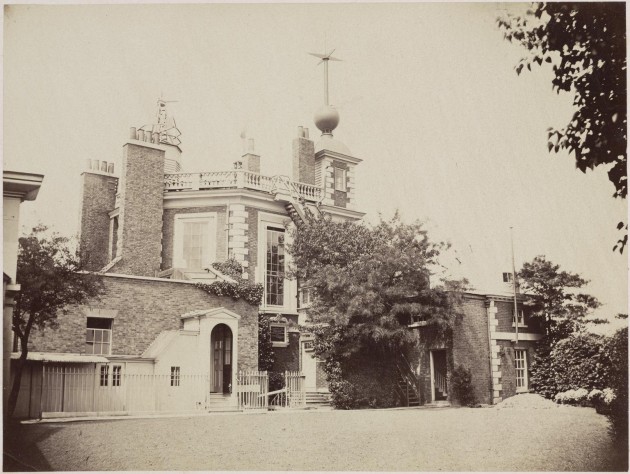
The east side of Flamsteed House c.1870 prior to the erection in 1876 of a small porch shelter in the form of a fan-roof of quadrantal form, above the orginal front door to Flamsteed House. © The Board of Trustees of the Science Museum. Reproduced under the terms of a Creative Commons Attribution-NonCommercial-ShareAlike 4.0 Licence (CC BY-NC-SA 4.0), details below
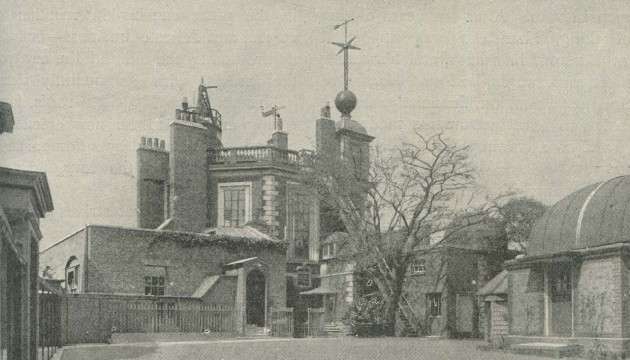
The east side of Flamsteed House in 1896. The building on the right is the Transit Pavilion erected in 1891. To its left, part of a wooden Transit Hut can be seen. It was used by the French observers when the longitude of the Paris Observatory was determined in 1888, 1892 and 1902. From a London Stereoscopic and Photographic Company photograph published in volume II of Pearson's Magazine
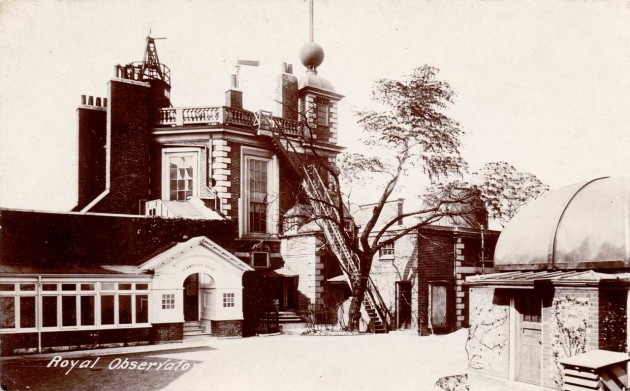
The east side of Flamsteed House following the upgrading of the covered walkway and entrance porch in 1906/7. The wooden Transit Hut is no longer present in the courtyard. Postcard published anonymously, but probably by Perkins and Son (P&S) in about 1908
The section of walkway adjoining Flamsteed House was an eyesore both before and after conversion. By the time Spencer Jones arrived in 1933 it seems to have been put to use as a conservatory. He asked for its removal, and for the original railings to be restored, but this was declined on grounds of cost, an alternative scheme being put forward without the railings. Spencer Jones thought that without the railings, ‘the appearance would be far from satisfactory’, so the conservatory remained (RGO8/36). Although it was finally removed in the 1950s, evidence of its former presence can still be seen in the brickwork towards the top of the window.
Excavation of the basement for Dyson
Dyson already had six children at the time of his appointment. In order to accommodate the family, the rest of the basement under Airy’s extension was excavated in 1911 prior to the arrival of his family in order to create additional rooms.
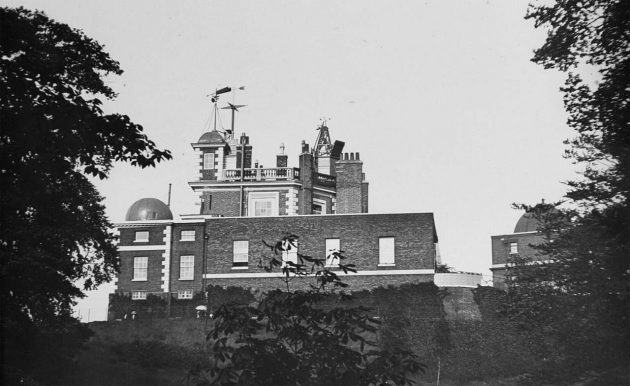
Flamsteed House from the west as it would have appeared from around 1890 until the excavations started. From a magic lantern slide published anonymously
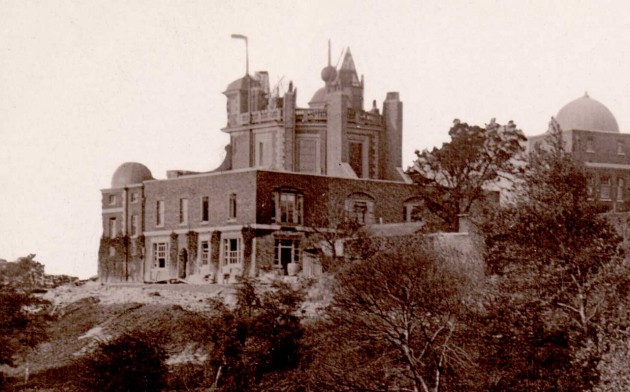
Work in progress on creating the new basement rooms. One of the new window openings has yet to be completed. Detail from postcard No. 7675 published by Mc Queen of Greenwich
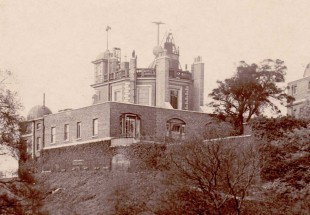
The west side of Flamsteed House in about 1900 before the basement was excavated. Detail from a postcard published anonymously
Airy’s staircase leading down to the basement level was both enlarged and turned though 90° to its present position (creating the staircase used in the galleries by museum visitors today). For greater privacy; the path alongside in the park was moved back by 8 feet and an iron fence erected. At the same time, the roof on this part of the building was changed from a double-pitched slate roof to a flat roof. The overall effect was described by Margaret Wilson, one of Dyson’s many children:
‘Flamsteed House after its alterations had an individuality and a charm all its own. The layout of the rooms was unconventional. You entered at the front door of a long corridor, with rooms – both sitting rooms and bedrooms – on either side. At the far end of the corridor a large window looked down over the trees towards Greenwich. … At the far end of the corridor too was a staircase leading down, not up, to other bedrooms, and to the pleasant dining room ‘on the tree-tops’ as Mrs. Dyson would say. The higgledy-piggledy arrangement of the bedrooms and living rooms gave the house its individual character.’
It was the Dyson children who were responsible for at least some of the Graffiti carved into the brickwork of the buildings.
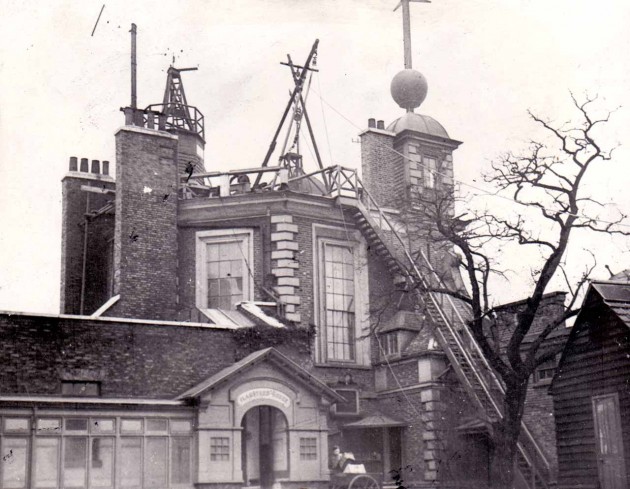
The balustrades on the roof of Flamsteed House undergoing replacement in the winter of 1923/4. Made of wood, they need continual maintenance and have been replaced or repaired many times since
Alterations for Spencer Jones
Following Spencer Jones’s arrival as the new Astronomer Royal on 1 March 1933, yet more structural alterations were made to Flamsteed House. On the south side, the internal wall separating the drawing room from its neighbour was removed to create what the plans describe as a dining room. Also removed was the wall between the passageway and the first room on the left as you entered the house, in order to create a proper entrance hall. The house was also rewired and redecorated.
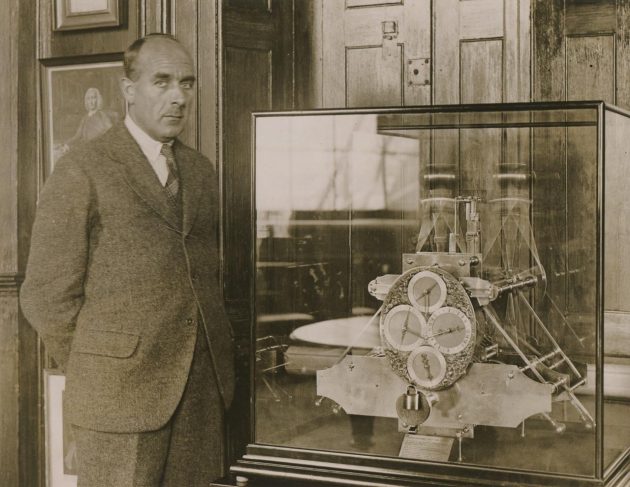
Taken in the Octagon Room in the first week of March 1933, this photo shows Spencer Jones with John Harrison’s sea-going clock H1, which had recently been restored to working order by Rupert Gould and had arrived back at the Observatory on 3 February. Harrison’s portrait can be seen on the wall to the left. The large Octagon Room table can be seen reflected in the glass case as can one of the windows on the opposite side of the room. The shutters covering the window behind the clock were removed in the 1950s when the room was converted for museum use
After Spencer Jones departed for Herstmonceux in 1948, the house was divided. The Observatory retained the use of some rooms, whilst the remainder provided two temporary flats for the use of Naval Officers from the nearby Royal Naval College.
Heating the house
The 1750 extension incorporated a massive chimney on the western side that rose above the leads of the Octagon Room. This was taken down during the 1789/90 works and replaced by a pair of similarly tall but slimmer chimneys tied into the external brickwork of the Octagon Room. Of the four main ground floor rooms built by Wren, all were built with fireplaces in a corner adjoining an external wall except for the hall (C) in plan below (left), which originally had none, but acquired one later, possibly in the late 1740s when the windows were enlarged. It shared a flue with the room behind (G). The four fireplaces were later moved, from the corners to the middle of the internal walls, necessitating three of the four flues to rise at an angle towards an outside wall from where they rose within the walls of the Octagon Room to the chimneystacks above. It was probably then, that the shared flue was separated, into two separate ones, both of which fed into the same chimneystack. Quite how this was arranged is not clear, nor when the fireplaces were moved. Plans and sketches indicate it was sometime between 1780 & 1831, but a date of around 1790 seems most likely.
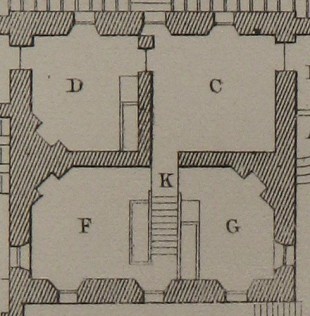
Flamsteed's apartments. Location of the fireplaces c.1676. The staircase (K) was removed when Maskelyne's extension was built in 1789/90. At the same time, the west and east windows in rooms (F) & (G) were moved slightly northwards
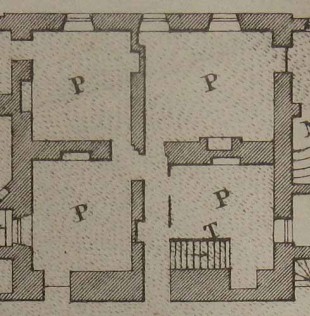
The same rooms in 1847 with the fireplaces in their new positions. The new staircase (T) was built for Airy in 1835/6 to give direct access to the bathroom below. In 1911, the west facing window (bottom left) was moved northwards to its present position
There was no fireplace in the Octagon Room, whose only form of heating until Maskelyne’s modernisations, appears to have been a Genoa pan – a portable form of heating stove, which as Flamsteed told Towneley in a letter dated 11 February 1676, ‘may on an hearth be wheeled about ye roome’ (RS MS/243/13). Maskelyne installed a 10-inch vent hole in the centre of the arched ceiling and later a stove in the alcove of the east window, the flue feeding into a new chimneystack immediately to its south (RGO6/21/169–170). Initially it smoked when the wind blew from the south or south-west, but was cured on 7 December 1789 when a modified chimney pot was fitted. At some point, most probably after 1846, a second stove was installed opposite the first, in the alcove of the west window. How its flue was routed is not known – suffice to say, it does not appear to have been vented directly through the window, as was sometimes the practice elsewhere. Both stoves, along with Maskelyne’s chimney were removed in 1911 when Dyson had central heating installed. This seems to have proved inadequate, as a number of gas fires were later installed.
When Airy’s extension was built it contained three west-facing rooms – two bedrooms and a drawing room (at the southern end), along with an internal bedroom, which was lit by an internal window opening onto the stairwell, which in turn was lit with a skylight. The flue from the fire in the new drawing room and neighbouring bedroom fed into in a new brick chimneystack that ran externally up the walls of the Octagon Room. A copper flue from a stove installed in the corridor passage at some point within the next ten years was subsequently routed alongside it (externally). The internal room whose fireplace was in its south-east corner, appears to have shared the flue from Flamsteed’s Kitchen. Meanwhile, the freestanding chimney that served the second (most northerly) west-facing bedroom proved troublesome and by 1838, had been replaced by an iron flue. But both the chimney and the iron flue failed to clear the top of the Octagon Room. With the prevailing wind from the southwest, as it veered in direction, the smoke must frequently have blown across the top of the room containing Pond’s 25-foot Zenith Tube, and towards the Octagon Room windows – not good news on either count. Without revealing their source, Airy told the Visitors in 1836 that he had ‘reason to think that much of the difficulty of seeing stars well defined, &c. [with the zenith tube] arose from the passage of currents of unequally-heated air near to the object-glass’. By 1846, the flue had been rerouted across to the outside wall of the Octagon Room and then up the old Wren stack from Flamsteed’s bedroom to which it was attached at the top. The zenith tube though was still a failure for other reasons. Following the absorption of the western summerhouse into the dwelling house in 1848, the presence of a cast iron flue protruding from the south side of the dome, suggest that a heating stove was installed on at least one of its three floors.
When in 1911, the central heating was installed; Airy’s external brick chimney was removed, rendering the drawing room fire inoperable. The two iron flues were also removed and an additional flue, perhaps for the boiler, seems to have been created within the (Wren) chimneystack to which the taller of them had been attached. At the same time, the neighbouring chimney (from Flamsteed’s kitchen) also seems to have had the number of flues increased – this time from one to two.
Although the original Wren chimneys had required rebuilding over the years, it has to be regarded as unfortunate that they, along with all the later additions were removed in their entirety during the 1950s renovations.
Cleaning the chimneys
Maskelyne was clearly fascinated by the different methods that were around for cleaning chimneys, copying several of them into his memorandum book. This one was copied from the 8 January 1803 edition of St James’s Chronicle (an early English newspaper), complete with the warning proviso at the end.
‘A cheap, easy & safe method of cleaning chimneys of soot. Mix 3 parts of salt petre, 2 parts of salt of Tartar, and one part of flower of brimstone very well & quickly in a warm mortar. Put as much as can be heaped on a shilling, on a piece of iron or fire shovel, over a strong clear fire, near the back of the chimney. If you have not a mind to hear the sound of the report, which will be as loud if not louder than that of the discharge of a gun, get away; and as soon as it begins to boil brown, it will cause such an explosion, as by the mere motion of the elastic air in the chimney, will without the least danger or damage, hurry down the soot as well or better than when generally swept by the hand. Should the chimney be very foul, the operation may be repeated, which will completely clean it.
While we applaud the benevolent attentions of our correspondent, we should be glad to be assured, that a shock sufficient to shake down the soot, might not, at the same time damage the chimney.’
Maskelyne clearly thought he would chance his luck, going on to record:
‘Mr Ferminger [Firminger was Maskelyne’s assistant from 1799-1807] has cleaned the Observatory [Meridian Building] chimney, this way, with intire success. Finds there is no danger of it hurting the chimney. He used as much of the powder as would lie on a half crown. The ingredients must be got pure and well dried separately on paper before the fire and then mixed together and pounded. He says a cloth should be put before the opening of the chimney to prevent the dust flying out into the room … .’
The roof as a functioning part of the Observatory
By the 1790s, the use of the Octagon room as an observing space had effectively ended. On the other hand, its roof, which had been devoid of instruments since Flamsteed’s time, was about to get a second lease of life. The first new piece of equipment to arrive was Maskelyne’s camera obscura, whose presence is first mentioned in the Observatory plans of 1778.
Thomas Evans, Maskelyne’s Assistant from 1796–98, later wrote:
‘There is in the western turret on this place a Camera Obscura, whose superior excellence has stood unrivalled, where all the surrounding objects, both moveable and immoveable, are beautifully pictured in their own natural colours, on a concave table of plaister of Paris of about three feet diameter. Few places in the world can be better adapted for a Camera Obscura than this, and it is impossible to leave this little room after being so amused, but with the greatest regret, even after taking a second or third view of it.’
One of those who was able to visit was the artist Joseph Farington who in his 14 August 1794 diary entry records that he was given access and permission 'to trace the outline of the view of London from it'. The completed drawing was later engraved by Joseph Stadler and published in 1796 by Josiah Boydell in his A History of the River Thames.
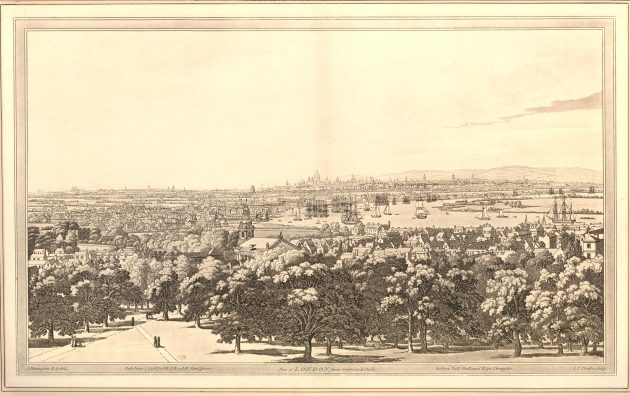
The published version of Farington's drawing made with the Camera Obscura. © The Trustees of the British Museum (CC BY-NC-SA 4.0). Museum number 1880,1113.5535. (see below)
Farington however was not the only artist to gain access to the camera obscura and have his drawing published. Edward Pugh had two images published in 1804. Interestingly, the Farington engraving makes no specific mention of the camera obscura, but the two by Pugh do. One of them is reproduced below.
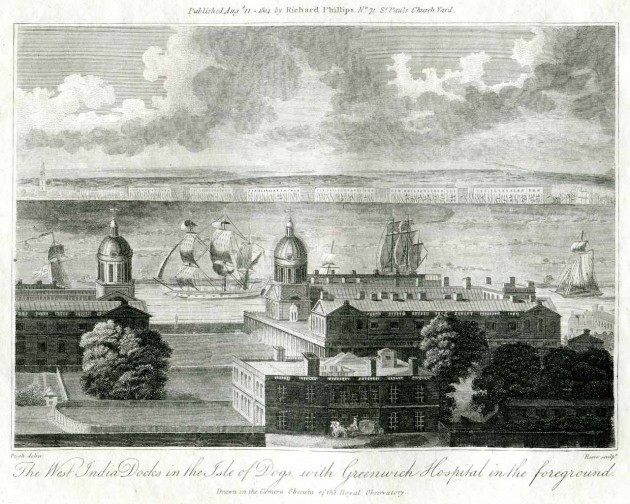
The West India Docks in the Isle of Dogs with Greenwich Hospital in the foreground. Drawn by Edward Pugh in the Camera Obscura of the Royal Observatory, engraved by Thomas Reeve, and published by Richard Phillips on 11 August 1804. Together with a second view by Pugh with the title The Cities of London & Westminster accurately copied from the table of the Camera Obscura in the Royal Observatory at Greenwich, it was one of numerous copper plates included in Modern London; being the history and present state of the British Metropolis (1804)
The Camera Obscura was joined by a theodolite hut in the centre of the roof in 1817, for use by Captain Kater during his re-determination of the longitude of the Paris Observatory. In 1833, the time ball was installed by Pond on the eastern turret. Made of black leather on a wooden frame, it was blown down in a gale on 7 December 1855. It suffered further damage in 1913, was temporarily repaired, and replaced with the present aluminium ball on 16 June 1919, which is when the colour appears to have changed to red – perhaps as a result of the primer never being over-painted. The ball, has been pillar-box red since 1960, and is still in full working order and in operation today.
Under Airy, the roof became home to a collection of meteorological instruments – a rain gauge and two anemometers. The first of the anemometers, an Osler was mounted on the western turret in 1840/41, displacing the camera obscura from within. The second, a Whewell arrived in the summer of 1843 and was mounted on top of the theodolite hut. The hut blew over on 12 March the following year and having being damaged beyond repair, was replaced by a new one. It was moved from the centre of the roof to its southern edge in 1866, and fitted out with a Robinson’s anemometer, replacing the Whewell’s, which had been previously been dismounted (in 1863?). In 1896, a sunshine recorder was fitted. The hut was replaced for a second time in 1936/7. But by then, it wasn’t the only wooden structure on the roof, a small wooden lean-to adjoining the Ball Turret having been erected in 1929. This housed a carbon arc and the accessories required for observations of stellar temperatures that were being made with the 30-inch reflector.
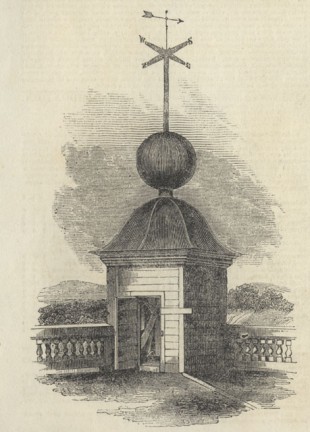
The time ball on the eastern turret. From the 9 November 1844 edition of The Illustrated London News
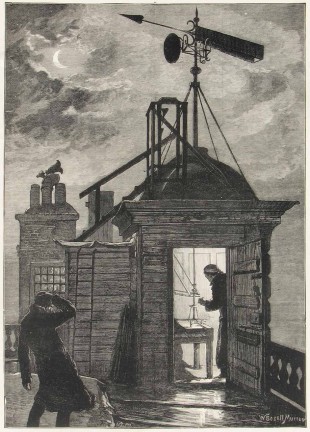
The Osler Anemometer on the western turret. Measuring the Wind, from the 31 January 1880 edition of The Illustrated London News
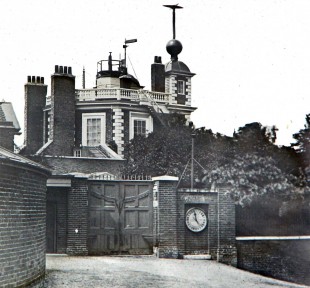
The roof of Flamsteed House in the early 1860s. The telegraph pole carrying the galvanic wires can be seen above the left of the two windows. To its right is the hut carrying the Whewell Anemometer. Magic lantern slide published by Williams, Brown and Earle, Philadelphia
In 1919, a new pole was erected on the roof; this time to carry an aerial wire across to the north-west corner of the South Building for the reception of radio time signals from the Eiffel Tower in Paris. It came into use in August and was replaced by a taller mast (a flagpole) in 1925/6. The aerial was removed in 1931/2 and the mast used to carry a flag. With the prevailing winds coming from the south-west, the flag was prone to occasionally catching in the Robinson anemometer. Spencer Jones eventually had the pole moved from the anemometer’s west side to its east in 1937/8. But it didn’t remain there for long. It was permanently removed early on in the war.
Alterations to the summerhouses
As originally built, the entrances to the two summerhouses faced one another at either end of the Terrace in front of Flamsteed House. The plans show that the doors were not in the centre, but offset to the north. The eastern summerhouse was used by Flamsteed to house a camera obscura. What he used the western one for is unclear, as is the use of both summerhouses during the tenures of Halley, Bradley and Bliss.
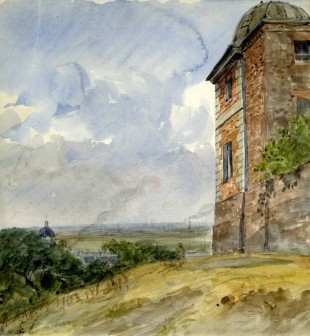
The West Dome (Western Summerhouse) with one of the domes of Greenwich Hospital to its left. Signed T Hollis, this view was probably painted in about 1820. The boundary wall (right) was moved a few metres westwards to this position in about 1790. The two south facing windows (extreme right) were blocked in 1835 when Flamsteed House was extended for Airy. © British Museum (museum number: 1929,0531.4)
Externally, the lower brickwork at basement level is different on the two summerhouses – the western summerhouse has English bond whilst the eastern one has Flemish. It is not clear if they were originally built like this, or if the difference is a result of partial rebuilding during the conversion process. As a whole, the appearance of the converted summerhouses must have seemed a little odd. The new upper stories were built of red brick to match the original. Surprisingly, the staircase extensions were built not of red brick, but of yellow/pink stocks. The basement levels too were of yellow/pink stocks as they presumably had been since Flamsteed’s time.
Known to start with as the East and the West Domes, the converted summerhouses originally housed a pair of equatorial sectors by Sisson which were used for the observation of comets. Later they became known as the North-East and North-West Domes and then as the North and North-West Domes. In 1816, the Shuckburgh Equatorial was installed in the East Dome, the mountning on a newly constructed pier in the Meridian Building having been found insufficiently stable to hold it. The telescope, which was made by Ramsden in 1791, was the world’s first large equatorial and was presented to the Observatory by Shuckburgh’s heir in 1811. It suffered from many deficiencies and was described by Pearson in 1829 ‘as proof of its former proprietor’s munificence rather than of its maker’s success’.
Following the enclosure of the Courtyard, in the 1790s, the eastern window of the North Dome was converted to a doorway. By the 1840s, the ground floor room had become nothing more than a passageway from the Courtyard to the Terrace. In about 1849, Airy brought it back into use as a room by creating a new doorway at the foot of the stairs on the southern side of the Maskelyne’s staircase extension. At the same time, the staircase window was bricked up, as was the doorway onto the Terrace, whilst the doorway from the Courtyard was converted back into a window. A knock-on advantage for Airy was that the alterations would also have led to an increase in the privacy of the rooms of his private apartments that overlooked the Terrace.
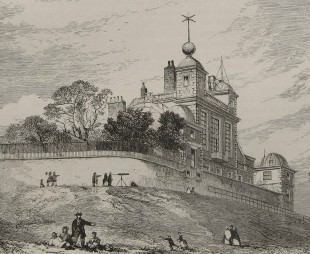
The Observatory, with the Time-Ball on the East Turret. From a photograph by James Glaisher, probably taken in May 1857. The image was published in the 1862 volume of The Leisure Hour and the 1891 edition of Dunkin's The Midnight Sky. The two windows in the basement of the North Dome (Eastern Summerhouse) are clearly visible
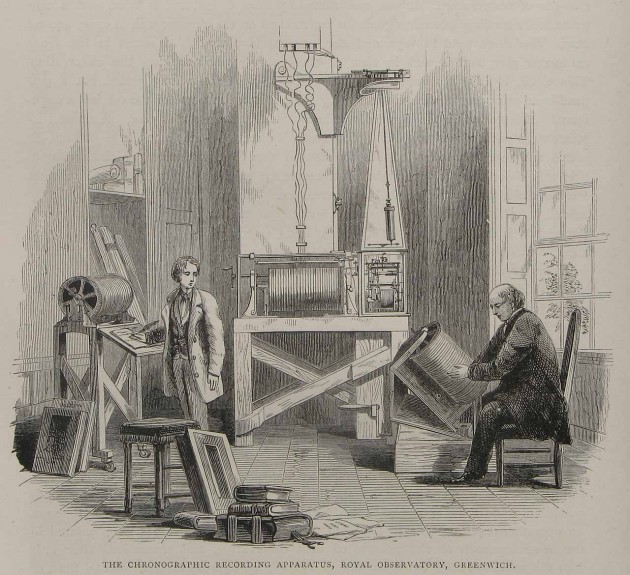
The Chronograph Room on the ground floor of the North Dome (Eastern Summerhouse). Originally published in the 1862 volume of The Leisure Hour, the image was reused in the 1891 edition of Dunkin's The Midnight Sky. The window is on the east side of the room. The table in the middle is in front of the north pier supporting the telescope on the floor above, whilst the shelves on the left are in the bricked up doorway to the North Terrace
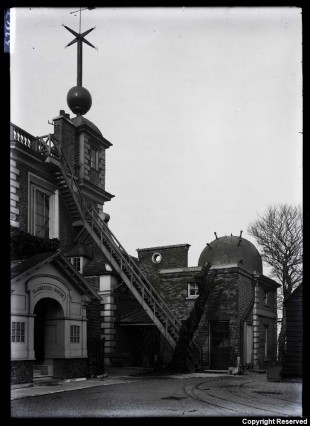
The North Dome (Eastern Summerhouse) in 1928. The Rugby Room was located on the ground floor. Halley's tombstone can be seen to the right of its entrance immediately adjacent to the drainpipe. The circular hole at the top of the wall to the left of the dome was introduced by Airy in 1880 so that a new Azimuth-Mark fixed on the parapet of the Royal Naval College could be sighted through it for checking the Zero of Azimuth of the Altazimuth Instrument in the Meridian Building. © BT Heritage. Reproduced under the terms of a Creative Commons Attribution-Non-Commercial-ShareAlike (CC BY-NC-SA) licence (see below)
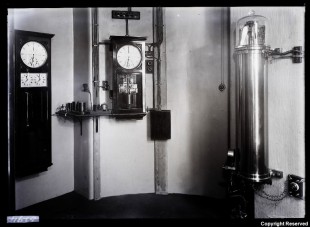
The Rugby Room in 1928. The clock on the left is the slave clock of Shortt 16. It is mounted on the bricked up doorway leading to the North Terrace. The Shortt 16 master pendulum is on the right. It is mounted on the south side of the north pier supporting the Shuckburgh Telescope on the floor above. © BT Heritage. Reproduced under the terms of a Creative Commons Attribution-Non-Commercial-ShareAlike (CC BY-NC-SA) licence (see below)
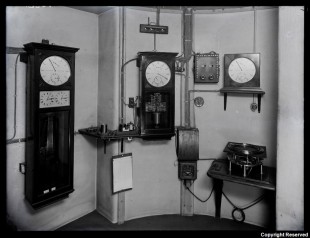
The Rugby Room in 1935. By then, the Shortt 16 master pendulum had been moved to the Clock Cellars. © BT Heritage. Reproduced under the terms of a Creative Commons Attribution-Non-Commercial-ShareAlike (CC BY-NC-SA) licence (see below)
When Flamsteed House was converted for museum use during the 1950s, the roofs of the two summerhouses were restored to their appearance in Flamsteed’s time and Maskelyne’s staircase extension to the Eastern Summerhouse was removed and the basement beneath filled with rubble and paved over. The fate of the basement beneath the rest of the eastern summerhouse is unclear. There is no obvious means of access and the ground floor appears concreted over. Halley’s tombstone was removed before the extension was demolished and subsequently placed in its current position on the south side of the summerhouse. In 1994, a modern camera obscura by Peter Drew was installed on the ground floor to provide a view of Greenwich for visitors.
The Clock Cellars
The main cellars of Flamsteed House are under the north-east corner of the Octagon Room. Originally used for the storage of wine, they consist of two adjoining vaults, each with a brick roof, and each having a wall abutting the North Terrace. During the First World War, they were used as an air-raid shelter.
The use of the cellars for timekeeping purposes began in 1856 when the small supplementary cellar at the foot of the Octagon Room staircase was cleared of a large quantity of old iron and brasswork from old instruments and its floor lowered before being knocked through to the basement of the North Dome staircase by the creation of a subterranean passage (ADM190/4/281). At that time, the basement of the North Dome contained galvanic batteries that were used in connection with the time service. The newly adjoining cellar provided much needed space for the storage of additional batteries. The American astronomer Maria Mitchell who visited Airy in August 1857, recorded the advice he gave her when descending the ladder to the basement: ‘Turn your back to the stairs, step down with the right foot, take hold with the right hand; reverse the operation in ascending; do not, on coming out, turn around at once, but step backwards one step first.’ What we don’t know, is who went up and down the ladder first – him or her? Nor do we know what the procedures were for getting the acid filled batteries safely in and out.
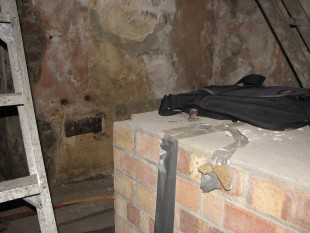
The west wall of the small cellar beneath the Octagon Room staircase. The brick plinth in the foreground was built in the late 1930s to support a quartz clock
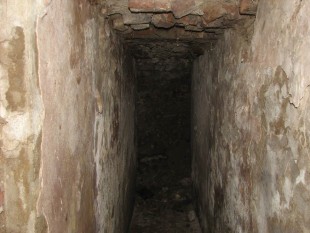
The passageway leading eastwards from the cellar towards the now filled in basement of the summerhouse
Airy’s plan of 1846 shows that at that time, there was a staircase down to the cellar that ran downwards in a southerly direction along its eastern wall. It is not shown on the 1871 plan. It was most likely removed in 1856, not least because in 1857, it was the ladder in the summerhouse that Airy took Maria Mitchell down to view the batteries and other equipment and also, had it been retained it would have restricted access to and from the new passageway. A small bricked up opening exists in the western wall separating this cellar from the former wine cellars beneath the Octagon Room. Seemingly just three bricks wide and six or seven courses deep, it appears to be of ancient origin. No opening is shown on any of the known plans (1760s, 1846 and 1911), suggesting that the original opening may date from the time of Greenwich Castle. The Board of Visitor minutes for 1860 record that a stove was installed in the cellar in 1859/60, but no record has been located that shows the position of its flue. It continued in use as a battery room until 1921/22 when a small room under the photoheliograph dark room in the Meridian Building was utilised instead.
It was the ability of the wine cellars to provide a stable temperature together with their massively constructed walls that lead to the clocks themselves being mounted in them. But this wasn’t until 1924/5, when one of the two (the eastern one) was adapted to house a new standard clock.
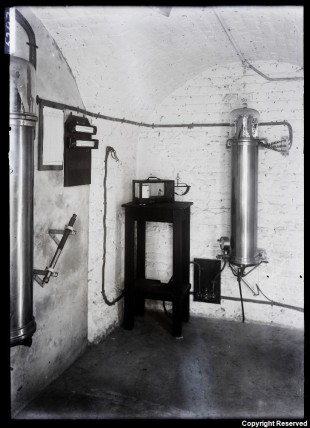
The original Clock Cellar in 1928. The clock on the left is mounted on the east wall and is the Shortt 3 master pendulum. That on the right is on the south wall and is Shortt 11 master pendulum. © BT Heritage. Reproduced under the terms of a Creative Commons Attribution-Non-Commercial-ShareAlike (CC BY-NC-SA) licence (see below)
Had a man from the street been able to visit the Clock Cellar he would have entered via the Nanny's kitchen in the basement. On arriving, he might have been forgiven for wondering where the clocks actually were, for nothing in the cellar had any form of dial or means of displaying the time. That’s because the clocks were of a revolutionary new design. They consisted of two parts – a pendulum that swung in an evacuated chamber – the ‘free pendulum’ and a ‘slave clock’ which was regulated by it though an electrical connection. Designed by William Hamilton Shortt in conjunction with F Hope Jones, they were manufactured by the Synchrome Company. They are known as the Shortt free-pendulum clocks. Relatively few were made, and each is numbered. It was only the free pendulums that were mounted in the Clock Cellar, the Slave clocks being mounted elsewhere in the Observatory.
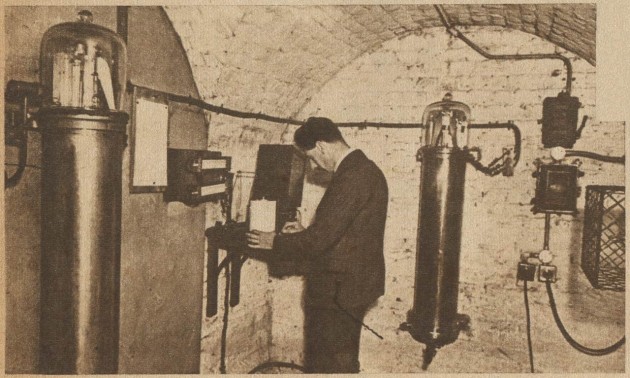
A second wider angle view of unknown (but possibly earlier) date. The person is thought to be William Bowyer who was in charge of the Time Department from 1917 until 1936 when he retired. From the 24 February 1946 edition of Le Patriote Illustré
The first clock to arrive was Shortt No.3. It was delivered on 21 November 1924. Its free pendulum was set up in the cellar and the associated slave clock in the Clock Room in the Meridian Building. The next clock to arrive was Shortt No.11. It was delivered on 20 May 1926. The free pendulum was set up in the same vault as No.3, but so as to swing in a plane at right angles to it. The slave clock was set up beside that of No.3 in the Clock Room in the Meridian Building. The thick cellar walls were important because they would have minimised the mutual interference that always arises between pendulum clocks when they are mounted together on the same wall.
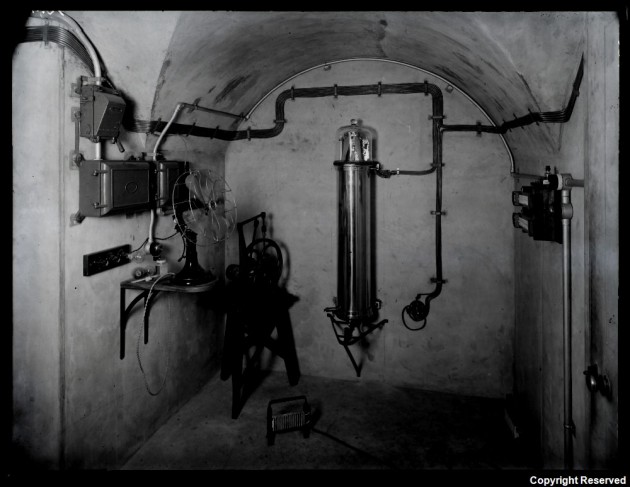
The second Clock Cellar in 1935. The clock is the master pendulum of Shortt 16. It is on the south wall. The handle of the door leading into the cellar can be seen on the right. The passage leading to the inner cellar is on the left. © BT Heritage. Reproduced under the terms of a Creative Commons Attribution-Non-Commercial-ShareAlike (CC BY-NC-SA) licence (see below)
On his appointment as Astronomer Royal, Spencer Jones was clearly unhappy with the access arrangements; so in 1933, a new entrance to the Clock Cellar, opening onto the Terrace was constructed. This was done by converting the western of the two windows of the room that Airy had used as a larder into a doorway and building a set of steps running down to it in an easterly direction from the Terrace. The steps and entrance have since been removed and the terrace and window reinstated. In 1933/4, the adjoining cellar was converted to house more clocks. Its walls and ceiling were rendered, a new concrete floor and steps were cast and a thick lagged door provided to reduce the leakage of heat. The clocks installed there were: Shortt No.49 which was delivered in November 1934 and the free pendulum of Shortt No.16, which had been delivered in 1927 and previously mounted alongside its slave clock in the Chronograph Room. Shortt No.40 which arrived in 1936 was mounted in the cellars too, most probably in the vault housing Shortts 3 and 11. In early 1941, following the outbreak of war, Shortts 3, 11 and 16 were sent to the Royal Observatory, Edinburgh where a reserve Time service was being set up. They were returned to Greenwich in 1946, where they were cleaned and overhauled, and then remounted. In his book, British Time, de Carle describes visiting the cellars:
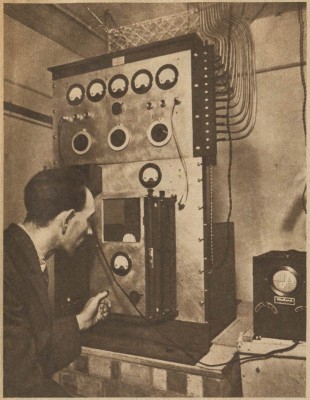
George Rickett with the new Quartz Clock in about 1939. From the 24 February 1946 edition of Le Patriote Illustré
‘We enter by way of a few stone steps from the terrace which runs just in front of the residence facing the River Thames … . At the foot of the steps we come to a passage, and a door on the left opens into a small room, with concrete floor and brick walls; on the floor are several small eclectic stoves, controlled by a thermostat, and an eclectic fan to ensure an even temperature. Firmly bolted to the walls, one at each end, are 2 Shortt free-pendulum clocks, but no dials showing the time – they are attached to the slave clocks in another room. … A thermograph, an instrument similar in appearance to a barograph, shows that the temperature has been consistently 68º F. Another door leading from this room opens onto a similar room, similarly appointed, but with 3 clocks. Coming out again onto the terrace and eventually to another small room … we see the 5 slave clocks which are connected to the 5 Shortt free-pendulum clocks just inspected.’
In 1938/9, Spencer Jones’ larder (a bathroom in Airy’s time) was divided to accommodate batteries for the regular time service and also the high capacity cells required to provide the current for the recently introduced quartz clock in the event of an interruption to the mains supply. The new Battery Room occupied the northern half of the converted larder. Meanwhile, a new larder was created by erecting a partition in the laundry room (also referred to as the scullery). The clock itself was placed on a specially built brick plinth (which still survives) in the small cellar beneath the Octagon Room stairs that had previously been used as the battery room extension. The clock was relocated to Abinger in 1943.
Other clocks in Flamsteed House
Apart from the cellars, three spaces in the main body of Flamsteed House were used to house clocks for scientific purposes. These were the Octagon Room (mentioned above) where clocks were installed in 1676, the ground floor lobby by Flamsteed’s front door at the bottom of the Octagon Room staircase where a clock was first installed in 1856, and the Laundry Room in the south east corner of the basement which was used for a couple of weeks in January 1856 when Clock Earnshaw was installed in connection with the Harton Colliery Experiment for determining the mean density of the Earth. Click here to read more about the clocks.
The two world wars
The Observatory escaped virtually unscathed in the First World War, apart from an incident that occurred on 19 January 1917, when 50 tons of high explosive were detonated by a fire at a chemical factory across the river and downstream in Silvertown. The blast shattered many windows, including Airy’s plate-glass one in the Octagon Room, which was subsequently replaced. (Note: The Royal Commission on Historic Monuments (England) London East, (London, 1930) describes (incorrectly) this particular window as being fitted with a modern sash). Click here to read the account of wartime life at the Observatory written by Margaret Wilson, the daughter of the Astronomer Royal, Frank Dyson.
The Astronomer Royal (Spencer Jones) remained at Greenwich until the start of the Blitz in the autumn of 1940, when he evacuated himself to the magnetic observatory at Abinger. Although Flamsteed House was not hit directly, considerable damage was caused to the ceilings, windows and window frames by the blast from bombs that fell nearby – particularly one that struck the main gates on 15 October 1940. Parts of the building had been sufficiently repaired to allow Spencer Jones to move back into residence in October 1945. The Octagon Room however remained out of use, its ceiling propped up with scaffolding and its windows boarded up with tarpaulins.
Conversion into flats and then into a museum
Even before it had been announced that the Observatory would be moving to Herstmonceux, the various parties began to position themselves regarding the future use of the site and historic instruments. The Admiralty (to whom the Astronomer Royal, Spencer Jones, was accountable) was keen to use Flamsteed House as temporary accommodation for some of its officers stationed at the nearby Royal Naval College. The Ministry of Works (MOW) was keen to use it in the short term to house one of their park-keepers rather than repair one of their dilapidated lodges. The Science Museum had eyed up the redundant instruments with a view to acquiring them and the buildings as an annex of its main site. The National Maritime Museum (NMM) had eyed it up too, and on and off though the war, its Director was engaged in informal talks with Spencer Jones. For his part – although he had no direct say in the matter – Spencer Jones was keen to see the northern part of the site preserved (the part that today’s visitors are charged to enter) and become a museum of Astronomy and Navigation under the management of the National Maritime Museum. The Board of Visitors passed a formal resolution to this effect at their meeting in June 1950 after which it was also agreed by the Board of Trustees of the National Maritime Museum.
In June 1947, a preliminary survey of the Observatory site was conducted by George Chettle, the Inspector of Ancient Monuments. He suggested the possible demolition of the eighteenth and nineteenth century additions to Flamsteed House, and its restoration to its original seventeenth century state.
Under the terms of the Royal Warrants, the Admiralty only had a right to use the land for the purposes of the Observatory or the Astronomer Royal. If and when such use ended, the buildings were to revert to the management of the Ministry of Works (by virtue of section 22 of the Crown Lands Act 1851). In view of the continuing post-war housing crisis in the country, a compromise was reached and in was agreed that in the short term, the Octagon Room would be opened to the Public, the Astronomer Royal would retain use of some parts and that the rest of the building would be divided into two temporary flats for the use of Officers at the Royal Naval College. In order to minimise interference to the future occupants, separate entrances were created. Visitors to the Octagon Room were to enter through the original front door of Flamsteed’s time and leave via the same route, unless things were very busy, in which case, they would exit via Airy’s internal staircase of 1849 into a newly created lobby and out through Maskelyne’s front door. One of the flats was entered from a new internal door coming off this lobby. The other was entered via the northern terrace though the door into the western summerhouse that had previously been sealed up by Airy. Alterations to create the flats were minimal, and largely consisted of replacing the two walls previously removed by Spencer Jones, partitioning off the main staircase to the basement and bricking up a few doorways. The Officers took up residence on 3 March 1951, the larger of the two flats being occupied by the Dean of the Royal Naval College.
The Time Ball was brought back into operation on 26 October 1950 in time for the Festival of Britain. The Octagon Room was transferred to the Ministry of Works on 5 April 1951 in the hope that it too might be opened to the public in time for the Festival of Britain in May 1951. But this was not to be. Extensive dry rot was found in the roof, particularly in the main supporting beams; the delay in repairing war damage and the lack of windows for some twelve years being contributory factors. Rolled steel joists (RSJs) were inserted to carry the weight from above, by means of straps and bolts passing through the lead flats. While the repairs to the roof were in progress, a temporary roof was provided. By May 1952, the damaged timbers had been made good and work on the ceiling was in progress. A new plaster rosette was made for the centre of the room, based on those in the ceiling panels in the colonnades of the Naval College. Later that year, in November, questions were being asked in parliament as to whether it might open to the public at the time of the Queen’s coronation.
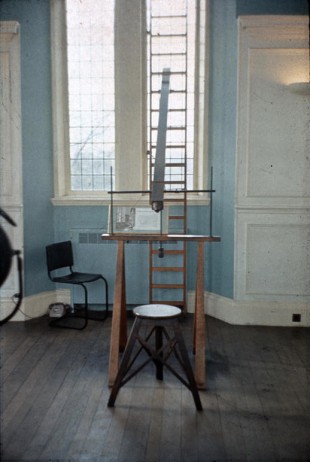
The blue and cream colour scheme of the Octagon Room. By the time the photo was taken, the linoleum had been removed from the floor. Undated colour slide courtesy Patrick Moore
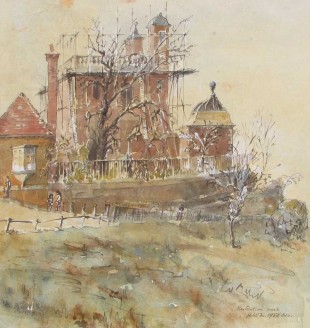
Hugh McKenzie, Restoration Work, December 1958. The chimneys have been removed from Flamsteed House as has the Time Ball in order to allow an extensive refit of its mechanism. On the summerhouse, Maskelyne's extension on the south side has been removed, and a new roof similar to that in Flamsteed's time is under construction. The Gatehouse which can still be seen on the left was demolished in 1960
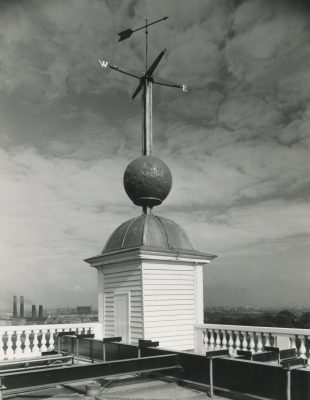
The roof of Flamsteed House showing the rolled steel joists carrying the weight of the Octagon Room ceiling by means of straps and bolts passing through the lead flats. The dents in the Time Ball occurred as a result of it being rolled across the courtyard following its temporary dismounting at the start of 1958. Ministry of Public Buildings and Works photograph No. G7903/8, June 1960
‘This splendid room, generally attributed to Wren, is newly painted with bright and glossy cream and blue-grey paint and the floor is covered with mottled yellow linoleum. The paint of the seventeenth century staircase is a dusty shade of green, treated to give an impression of antiquity. An even more surprising innovation conceived by the Ministry of Works is the glazing of the windows with a glass that effectively blots out one of the finest views in London.’
Panic ensued and an investigation was immediately launched at the Ministry. It transpired that the glass was specifically chosen for most of the windows so as to obscure the view of ‘a number of ugly roofs and chimneys’ and that its installation in the north window with its views of London had been made in error. The mistake was rapidly rectified and the comments about the paint ignored, though a note dated 20 May in the files indicates that the blue and white colours were chosed as these were the colours that survived beneath the numerous coats of later paint and that the shade of green had been used elsewhere at Greenwich without criticism (Work/17/369). An early document in the same file dated 25 April 1952 signed on behalf of Architect historic Buildings, P.L. Rothwell specified the colour scheme for the Octgagon Room as follows:
‘That the plasterwork of ceiling to be painted as directed in two colours, the flat surface of ceiling and dome to be a “Pale Wedgewood Blue No: 88/H.C.4” and the ribs and decorated plasterwork to be picked out in “Sung Cream No: 19/H/C/4” both supplied by Thos. Parsons & Sons Ltd.
The main cornice to by Sung Crem but the flowers, leaves and emblems to be picked out in white.
The walls and reveals to windows to be in Pale Wedgwood Blue, but the pannelling is to be finished full gloss pale ivory or parchment colour down to the floor.
The use of chrome in this paint should be avoided if possible.’
Surviving, but undated images suggest that although broadly adhered to, the colour scheme may have been adapted slightly when the room was next decorated.
Communications between the two ministries and the National Maritime Museum were often poor. It was only in April 1953 for instance that the MOW wrote to the NMM asking what their plans were for the older part of the building. At this point, the MOW was working on the basis that the 18th and 19th century additions would be demolished. No reply having been received by July, the Ministry wrote again and this time received a very full reply stating that the Museum’s trustees were ‘extremely anxious’ that no demolition should take place and that the rooms should be converted into galleries. This view prevailed.
After much hassling from both the MOW and NMM about when its officers would leave, the Admiralty vacated the flats slightly earlier than had been originally agreed, allowing them to be transferred to the MOW in September 1954. At this point, a site meeting was held to discuss how the building might be opened up to create gallery space. It was agreed then, that the original Wren partitions should remain and that three large galleries should be created in the 18th and 19th century extensions with back of house facilities in the basement rooms of Maskelyne’s extension on the south side. Until the Observatory clocks that had been retained in the cellars were removed to Herstmonceux, work on converting the rest of the building was unable to proceed. It took until late 1957 for this space to be vacated.
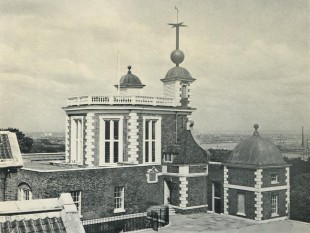
Flamsteed House at the time of its opening to the public in 1960. From The Old Royal Observatory (HMSO, 1960)
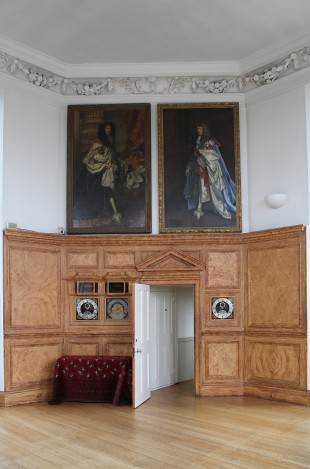
The 1990 decorative scheme of the Octagon Room. Photo by Tony Hisgett reproduced under a creative commons cc-by-2.0 license
Further remodelling of the building took place in 2005/6 when the previously replaced wall between the two rooms built by Maskelyne was removed once again. The external visitor lift to the south of the building that runs between the main floor and the basement was added at the same time, its installation requiring the remodelling of the steps nearby that linked Airy’s drawing room to the garden level a few feet below. The galleries re-opened to the public on 15 February 2006.
In 2021, the Octagon Room was closed for another major refurbishment that involved changing the colour scheme for a third time and replacing the floor for a second. It reopened in the spring of 2022.
Image licensing
The images from the British Museum of the Octagon Room (Museum number: 1865,0610.952) and Farington’s drawing from the camera obscura (Museum number 1880,1113.5535) are reproduced under an Attribution-NonCommercial-ShareAlike 4.0 International (CC BY-NC-SA 4.0) license, courtesy of The Trustees of the British Museum. The Octagon Room image has been cropped and recompressed for this website.
The photographs of the clocks in the Clock Cellars together with those of the clocks in the Rugby Room and the view of the North Dome in 1928 are © BT Heritage. They have been obtained from The BT Digital Archives and are reproduced under the terms of a Creative Commons Attribution-Non-Commercial-ShareAlike (CC BY-NC-SA) licence. They are more compressed than the originals.
The image of Flamsteed House as it appeared between 1774 and 1789 has been cropped from a drawing by John Charnock and is reproduced under the terms of the Creative Commons Attribution-Non-Commercial-ShareAlike (CC BY-NC-SA) licence courtesy of the National Maritime Museum, Greenwich, London. Object ID: PAF2864.
The two watercolours reproduced courtesy of The Petersfield Bookshop were reproduced by Derek Howse in his book Nevil Maskelyne (1989) where they were recorded as being in the possession of Maskelyne’s descendent Nigel Arnold-Foster. Howse also reproduced the view from the east in volume 3 of Greenwich Observatory (1975). Both images are believed to have been photographed for Howse in the 1970s. When they left the possession of the Maskelyne’s descendents is not known. It is not impossible that they had already left the family when Howse’s book on Maskelyne was published.
The image of Flamsteed House in 1777 has been cropped from the page of a journal written by Thomas Bugge and is reproduced under the terms of the Creative Commons Attribution-NonCommercial-NoDerivs (BY-NC-ND) licence courtesy of Det Kongelige Bibliotek, Denmark.
The images reproduced courtesy of Cambridge Digital Library have been reduced in size and are more compressed than the originals and have been reproduced under the terms of a Creative Commons Attribution-NonCommercial 3.0 Unported License. Links to the individual images are as follows: image 1.
The c.1870 image of Flamsteed House is reproduced under the terms of a Creative Commons Creative Commons Attribution-NonCommercial-ShareAlike 4.0 Licence (CC BY-NC-SA 4.0) courtesy of The Board of Trustees of the Science Museum.
The paintings by Henrietta Smythe are reproduced by kind permission of The Scout Association Heritage Collection. Henrietta Grace Smythe (1824–1914) was the sixth of eleven children born to Captain (later Admiral) William Henry Smythe (1788–1865), a distinguished astronomer, fellow of the Royal Society and a member of the Observatory’s Board of Visitors from 1836 until his death. One of Henrietta’s two older brothers, Charles Piazzi Smyth (1819-1900), became Astronomer Royal for Scotland in 1846. The other, Warrington Wilkinson Smythe (1817–90), married Anna Storey Maskelyne, granddaughter of the fifth Astronomer Royal Nevil Maskelyne. In 1846, Henrietta married Baden Powell, the Savilian Professor of Geometry at Oxford who was 28 years her senior and previously twice married. Widowed in 1860 shortly after the birth of her tenth child, she changed the family name to Baden-Powell. Her son Robert was the founder of the Scout Movement.
The photo of the Octagon Room by Tony Hisgett reproduced under a Creative Commons Attribution 2.0 Generic (CC BY 2.0) licence via Wikimedia.
© 2014 – 2025 Graham Dolan
Except where indicated, all text and images are the copyright of Graham Dolan
